#yes it has all these same elements from the later books but they were sparse and were actually part of the plot
Note
Hi! I love you Shageera fic! The fandom is so small and your fic is so good, I can't thank you enough! And I wanted to ask you, do you have any headcanon about their relationship outside of Talespin? In the original Jungle Book "canon" or some other AU? I'd love to hear them if you do have them, your takes are gold!
Hi! Thank you so much!!
Hmmm. All the versions of shagheera in my head follows the same basic story structure of “friends as kids, grow apart as they get older, reconnect as adults” EXCEPT for the jungle book/canon universe, where the first two DO apply to them (thank you jungle cubs for making that canon, idk where I’d be without jungle cubs canon.) but they continue to keep their distance from each other once they’re grown. I mean Khan tried to kill Bagheera’s kid AND his bear husband. I don’t think they ever can bounce back from that one. They got bad blood and they probably always will.
Unless….just kidding…..unless….
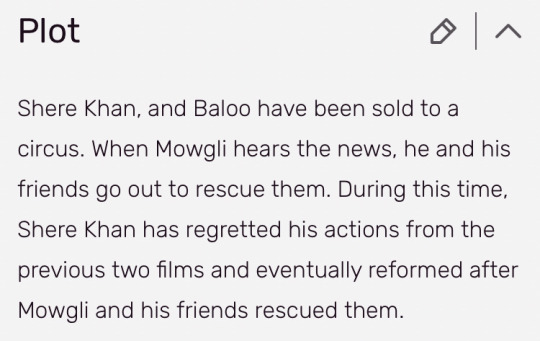
I think about the plot of this cancelled third jungle book movie very often. Yeah it would’ve been bad but….but….but adult Khan and Bagheera might have interacted. Also I wanna know how the fuck a shere khan redemption arc is written. Not very well probably but I still wanna see it. I think Disney should send me the script to this film. As a gift. I think I deserve it. It’s not like they want it. Hand it over, lads.
ANYWAY
Besides the talespin universe, I’ve got like two shagheera AUs
Treasure Planet AU — Bagheera is a scholar and astronomer who comes aboard Captain Shere Khan’s ship. The two know recognize each other as the childhood friend they used to play pirates with. So, rather ironic circumstances they’ve found themselves in. Neither know how to react to reuniting so they’re pretty awkward about it and refuse to acknowledge that they were ever close. They mostly interact with the distant politeness of people who barely know each other and strictly refer to the other Captain/Doctor (unless circumstances are dire) But they’re gonna be stuck on this ship together for the next few weeks so they better figure out what the fuck their relationship is.
Bagheera is deeply out of his element. He’s intimidated by the crew and he doesn’t know how to handle a weapon so he considers himself rather useless on this expedition. He’s never even held a pistol before and now he’s expected to know how to shoot one. He’s so frazzled that he nearly (accidentally) shoots Khan dead at one point. But he wouldn’t be Bagheera if he wasn’t stubbornly insisting that he knows what he’s doing, especially when the captain shoots some sardonic comment his way. The two get into more squabbles than he cane keep track of.
Shere Khan is exasperated with the doctor, with the boy he brought aboard, with the entire idiot crew he hired, but especially with the doctor. He attempts to keep himself composed but he keeps stooping to the most childish arguments and he feels like the presence of Bagheera is forcibly dragging him back 25 years every time they interact. Shere Khan does not know how to feel about that.
Shere Khan finds himself having to acknowledge that Bagheera is brilliant. Due to the doctor’s calculations, the ship avoided the waves of impact during a difficult path through a black hole and he’s the reason they got out alive. He never felt all that much admiration for the little brainiac when they were children but now he is absolutely blowing him away.
Bagheera starts spending more time in Shere Khan’s office because it’s the only place he feels comfortable. (The crew really creeps him out.) and they do everything from argue to discuss alternate routes to pour over the map. This evolves to Shere Khan teaching Bagheera what he knows about wielding a sword and they have many homoerotic sparring sessions. Sometimes they’ll lay out in the escape boats and Bagheera will teach Khan the names of all his favourite constellations. They have many homoerotic star gazing sessions. BASICALLY they have a gay space pirate love story but it’s behind the scenes stuff cuz Kit is the protagonist of this au and he doesn’t give a fuck what Shere Khan and Bagheera are doing.
They are forced to acknowledge that they care about each other when the stakes get more dangerous and both have their near death experiences, rattling the other considerably. At the very least they start calling each other by their first names again ❤️
Fairytale/ Dragon Princess AU — OKAY i don’t think I’ve ever publicly posted about this au so I won’t unpack all of it cuz I know y’all aren’t familiar with it. It’s mostly focused on Baloo/Rebecca and the bear family as a whole but Shagheera is involved too so I’ll focus on that part for now.
So basically Shere Khan was a kid prince and Bagheera was the son of a servant so, as the only two children in the castle, they’ve been playmates since before they could walk.
The only other children they interacted with were Bagheera’s friends (Baloo, Louie etc.) and Shere Khan’s wife-to-be, Princess Rebecca. Their parents arranged the engagement and neither Khan or Rebecca were thrilled about it. As they grow older, Bagheera leaves the palace to make his own way and he and Khan don’t keep in touch.
By the time they were young adults, mysterious circumstances paused Shere Khan and Rebecca’s upcoming marriage when word spread around that the princess had been horribly cursed and locked away in a tower. Details were sparse, even to her fiancé. All that was known was that she had last been seen talking with a man who had a reputation for being a dark mage and it can be deduced that he was the one behind the curse.
But before she disappeared, Rebecca sent Khan a letter begging him to please not retrieve her from the tower, warning him that whoever ventured out to save her would not make it back alive. Khan obliged of course, both because he respected her wishes and if she returned, he would have to marry her.
As a king, Shere Khan had excellent publicity. He was charming and charismatic in public, masking the fact that he was an absolute bitch in private. He was also obliged to act like he cared about his fiancée being returned to his side so every now and then he allowed whatever arrogant glory seeking fool who offered, to go “save” her. None of them lived.
Years later, Khan drops into an ancient, desolate library on the outskirts of town, hoping to find a particular book on plants. It’s after midnight, so he doesn’t have to deal with the scandal of the king being out and about. And who does he find between the shelves, bathed in the dim glow of oil lamps, but Bagheera, snoring on the floor in a pile of open books.
This begins a tentative acquaintanceship in which Khan escapes to the library every now and again for a change of scenery and to meet with Bagheera, who lives on the floor above.
It doesn’t take long for Shere Khan to learn Bagheera’s reputation. As it turns out, the passionate yet introverted scholar with books on the brain, is allegedly the “dark mage” that put a curse on Rebecca all those years ago. This would explain why his library is always empty. Everyone in town is petrified of him.
Rather than turn to anger or fear, Shere Khan can only feel disbelief and intrigue because whatever rumors are going around are clearly fabricated. He challenges Bagheera to perform some evil little spell for him, summon hellbeasts if he must. But Bagheera falters and it is revealed that underneath that reputation is a bit of a sham. Bagheera has been trying for years to become an adept mage but he just can’t get the hang of it. His spell-work is terrible. Always has been.
“Well surely you can’t have cursed the princess then?” Shere Khan reasons. But that’s not exactly true. Yes, Bagheera was not behind the original curse but when Rebecca came to him for help, he accidentally made it so so much worse. Bagheera is the reason shes been forced to hide herself away in a tower and he’s been spending all these years attempting to improve his magic so he can finally undo what he’s done.
And so Fairytale/Dragon Princess AU is a fantasy love story where Shere Khan attempts to help Bagheera effectively channel his magic. The fun part about it is magic is intricately tied to a persons emotional state so when you’re having homoerotic little scenes with your childhood buddy and he touches your forearm, you nearly set the whole goddamn library ablaze. Real gay shit.
I have run out of steam and cannot ramble anymore. Hope I have pleased you.
#this is very rambly and not very arresting I am sorry#I had a lot to say but not the worlds to say them
19 notes
·
View notes
Text
Air: “Endgame”

Eleven episodes and a two-week hiatus later (oops!)~~
My praise, my wishes, and my feelings of the season finale of Book I.
[Heart eyes.]
Oh, Bo. What would we do without you.
As always, he gifted us with his silly and endearing humor,
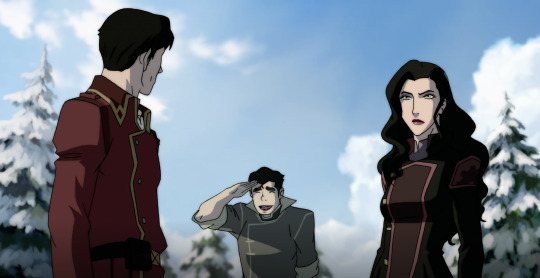
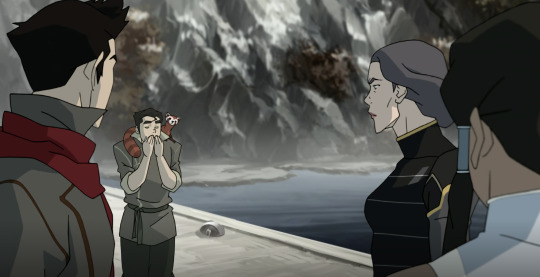
but he also starred in some fantastic collabs.
Bolin x Naga
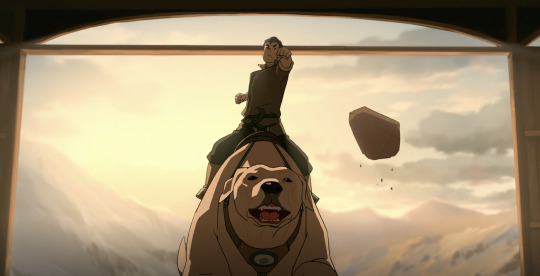
Bolin x General Iroh

Honestly, Bolin x Any Character <--- now that’s my kind of ship.
General Iroh is just as stupidly fearsome and heroic as his grandfather.
This is fact.
His stunt with the planes?
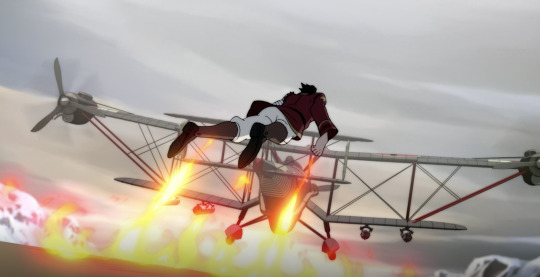


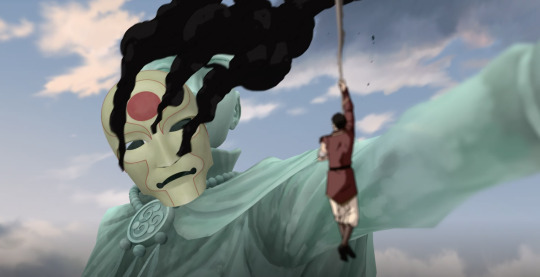
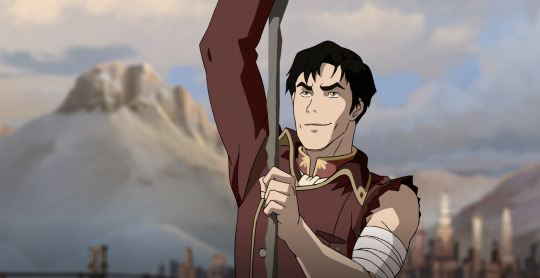
Cray.
I’m looking forward to seeing more of him in the future, preferably in the same scene(s) as Zuko because that’s something I desperately need in my life.
My favorite Mako: protective and powerful.
Let’s not forget, he can break free of Noatak’s bloodbending!!!




Korra---the freakin’ Avatar---couldn’t even do that! At least, not at first.
Amon admits it himself: “I'm impressed. No one has ever gotten the better of me like that. It is almost a shame to take the bending of someone so talented.”
I hope Mako’s talents become focal points in the next books. Please, oh please don’t revert him back to a frustrating, lovesick puppy who can’t make up his damn mind. It really doesn’t do his character justice.
Speaking of lovesick puppies...
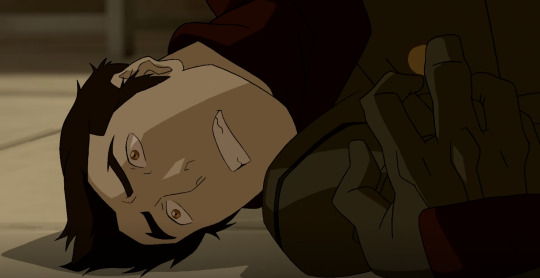
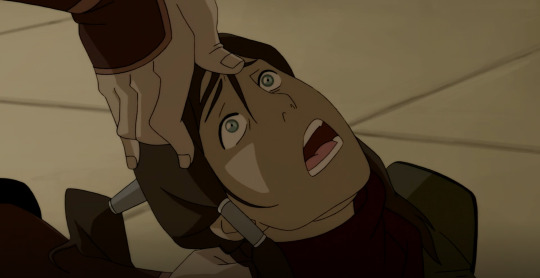
Without a doubt, Mako and Korra had the most compelling scenes of the entire episode (and not because they were fighting Noatak).
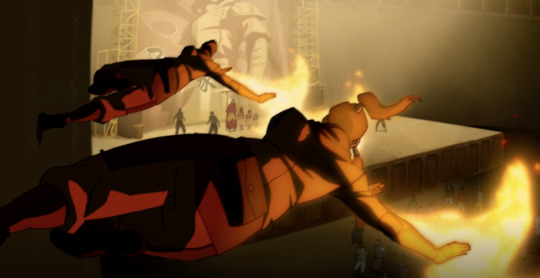


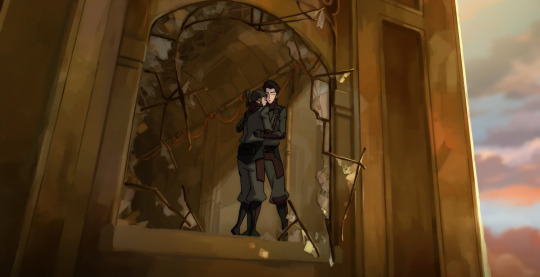
Canon couple or not, these two make a great team. They obviously care about each other, but they’re fiercely protective of one another as well, and that’s what makes their chemistry so palpable.
Although I wasn’t over the moon about dropping the love bombs, even I recognize how heartwarming their moments were.
Take, for example, the penultimate scene of the finale:
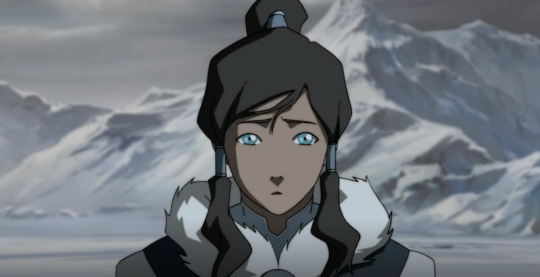
Recap: Mako tells Korra he loves her, Korra dramatically runs away with Naga, and Tenzin tells Mako they have to be patient with her, which is old people code for “give her some space.”
If you ask me, that’s shitty advice.
In real life, I want someone to go after me, even if I say I want to be alone or I tell people to go away.
Yes, I am that person.
So you best believe my heart SOARED when the boy chased after the girl:

At first, Mako’s shocked.
No surprise there.
He just witnessed Korra in the Avatar State, which means 1) her bending is back and 2) the Avatar State is no joke!! The glowing eyes!! The command of the four elements at your fingertips!! That’s hardcore, bro!!

But then he fondly smiles at her, which I wholeheartedly interpret as “Ah, yes. That’s my girl.”

And look at her face!!

These two aren’t endgame, so I’m allowing myself to savor in the swoon.
FYI: If there’s anything you should know about me, it’s that I’m a sucker for cheek caresses.

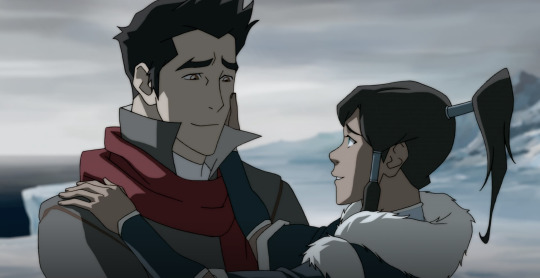
Twirling hugs also make me a lil weak in the knees.
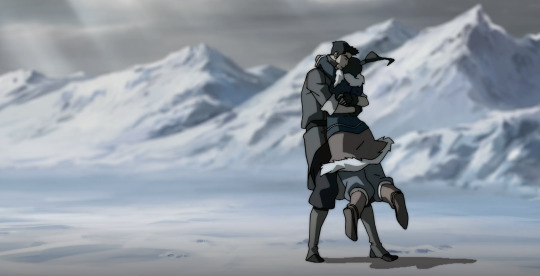

Running to someone and barreling into their arms is just stupid cute.
[Heavy sigh.]
I was really rooting for Asami.
After Chapter 7, I thought we were going to see how Asami was coping with the reveal of her father’s conspiring nature. Instead, her character seemed to revolve more around the love triangle (or whatever shape you want to call the ridiculous Asami x Mako x Korra situation). When Asami does mention her father, it’s only a sparse comment every other episode or so.
Thus, the showdown between father and daughter lacks an emotional weight, and it’s partly because we haven’t explored enough of their relationship to truly feel for these characters.
That isn’t to say their sequence doesn’t have powerful moments.
I just want to take a moment to holla at ma boy @Jeremy Zuckerman, sole music composer.
Your music is always stunning, but the accompanying track in Asami and Hiroshi’s showdown (plus the music in the boat scene and everything in the third act) is what carries the entire segment.
Your melodies tugged at my heartstrings in ways the story couldn’t.
Their final fight, for instance:
Asami is so caught up in the battle---defending herself against her father, no less---that you think she might actually do it, she might actually hurt him.
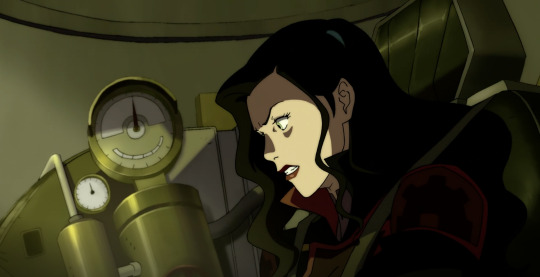
But then he’s looking at her like this,
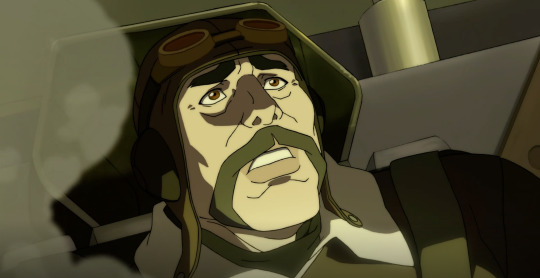
and she starts to hesitate (this is her father after all),
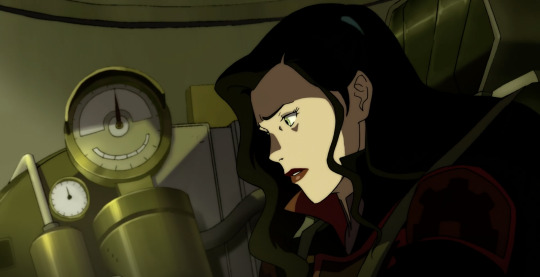
which is the exact moment Hiroshi strikes.
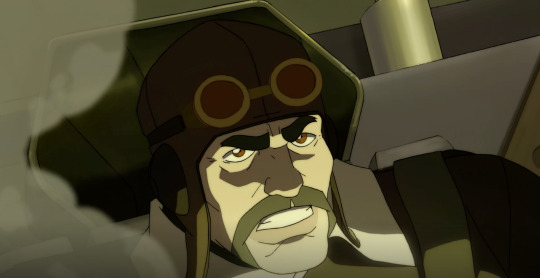
In the end, Asami captures her father, but not without remorse: “You really are a horrible father.”

Dear Creators,
Please give your characters the emotional depth they deserve and explore the nuances of their relationships.
Trust me: they can lift the weight of their stories just fine.

I am unbelievably disappointed in Noatak’s arc.
I just---
I mean---
How?
How are you going to build the foundation of a character on a lie?
How are you going to develop that character’s arc for ten episodes, then discredit almost everything with deceit??
How are you going to completely undermine your character like that???
And to add insult to injury, Noatak keeps lying, going so far as to reveal a fake, painted scar:
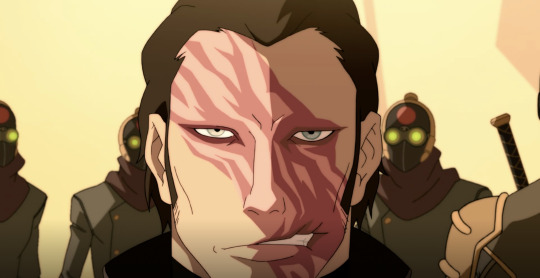
Here’s the thing: Zuko is my world.
Of all the characters from Avatar: The Last Airbender, I found pieces of myself in his story the most. Scars, then, are sore subjects for me; sometimes, I feel like I’m as sensitive about his scar as he was.
Yes, I jumped in my seat upon first seeing Noatak’s “scar,” but make no mistake---I’d rip that lie off his face in a heartbeat.
Undermining your character with lies is bad enough, but this shit felt like mockery, and while I’m certain that wasn’t the creators’ intents, I’m taking it personally anyway.
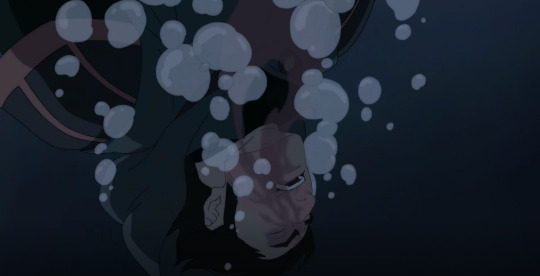

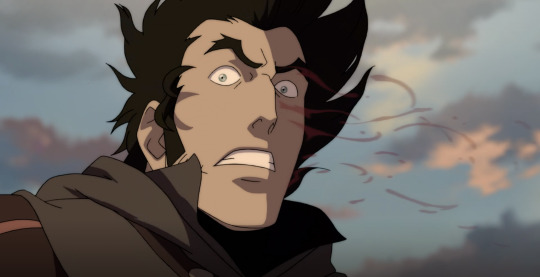
However, attention should be paid to Noatak’s last scene:
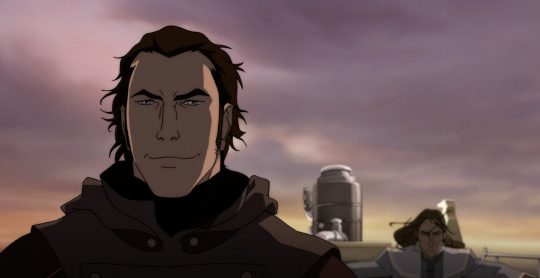
Again, the music is so beautifully somber, but the dialogue here is probably some of the episode’s best.
From Noatak’s “I had almost forgotten the sound of my own name,” to Tarrlok’s "It will be just like the good old days.”
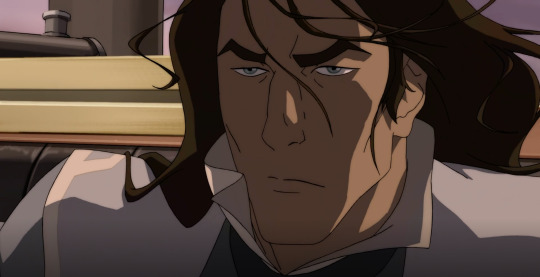
From the tear that rolls down Noatak’s cheek,

to Tarrlok's decision to sacrifice them both.

It doesn’t make up for butchering Noatak’s arc, but this was, quite simply, a beautiful ending to a sad story.
Dear Creators,
Please don’t make the same mistake twice.
You compromised the integrity of your character the moment you sacrificed a fleshed out plot for woaw!shock factor.
Villain or not, he deserved better.

Also, I CAN’T BELIEVE YOU.

It was at this moment that I wanted to jump into the screen and rescue Tenzin and his beautiful children myself.
LOOK AT THEIR FACES.
I WAS SO MAD.
LIKE:
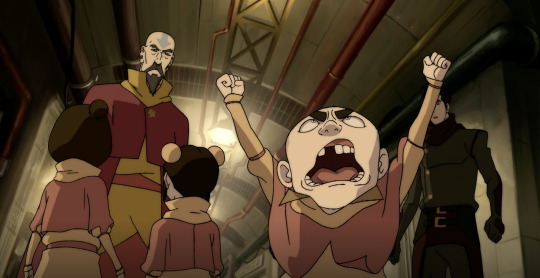
HOW COULD YOU.
It should be said: I loved Korra in this episode.
I mean, she was pretty daft to think that hiding under a table would keep her safe from a bloodbender. A bloodbender (a psychic one at that) can feel your blood, Korra, of course he knows you’re under there.
So just for that:
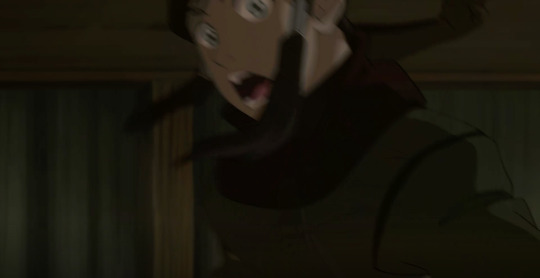
Yeah, don’t you look all silly and fuzzy.
Aside from this idiotic little slip, she was pretty badass, unlocking her airbending and fighting against Noatak’s bloodbending:

What a crappy screenshot of her airbending, haha. Would you believe me if I said this was genuinely the best I could do?
And unlike Asami and her father, I actually felt for Korra. I was devastated when Katara couldn’t repair her severed connection to the other three elements.
Though I wonder if I felt more for Korra because she acted just as I would. That is, she’s clearly distraught over losing her bending, but she wants to spare her friends and family the trouble of making a scene:

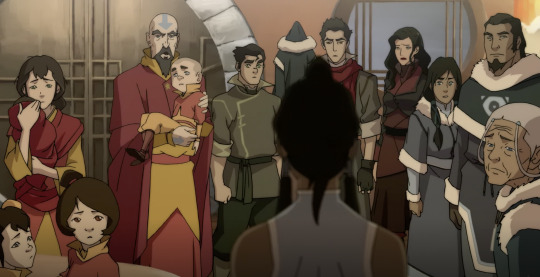
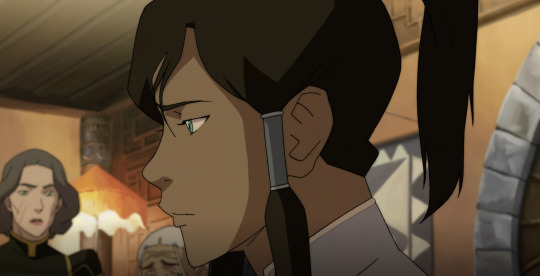
So she waits until she’s alone to let it all go:
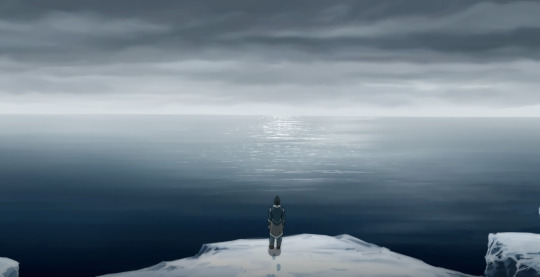
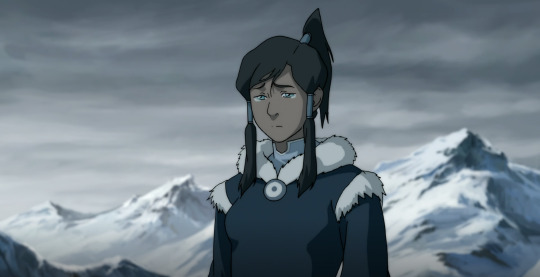

:’-(
As I said, I loved and felt for Korra in the finale, and I don’t have a problem with her...
I have a problem with the writing.
Korra’s airbending was very badass, but I completely forgot about her airbending struggles.
The first four episodes show Korra’s conflict with the element (i.e., it’s literally the plot line of Chapter 2). If anything, these episodes have small moments that remind us of Korra’s airbending training---practicing in the temple’s courtyard or doing exercises with the kids, to name a few examples.
Then, in Chapter 8, Tarrlok insults her with the “half-baked Avatar” comment, snidely remarking on her less than satisfactory airbending. It’s in this same episode that Korra reminds Tenzin---and the audience---that she’s never been able to connect with her spiritual side. (More on this later!)
And... that’s it.
After the eighth episode, she’s kidnapped by Tarrlok, who reveals himself as a bloodbender; she’s rescued but then Amon and Hiroshi attack Republic City, separating Korra and the teens from Tenzin, his family, and Lin; Korra decides to take Amon on her own (but not really because Mako decides to tag along) and the two of them bump into Tarrlok, who reveals that Amon is actually his long-lost, waterbending, psychic bloodbending brother, Noatak.
It’s not necessarily a bad thing. If the creators were prioritizing awe! and shock! and woaw!, then unlocking Korra’s airbending this way definitely did the job. But it felt a little too... convenient? Plus, there was no explanation for why her airbending worked when it did.
I mean, saving Mako obviously had something to do with it, and they didn’t have time to get into the details because, duh, they were trying to restore Korra’s bending.
Still, the audience shouldn’t have to interpret everything.
(Or perhaps I’m just being petty, lol.)
For a book titled after the element, I guess I just expected more.
Ultimately, I wish we saw Korra practicing more airbending; I wish we got an explanation for how and why she airbended when she did; I wish her success in unlocking her final element had not been overshadowed by the loss of her water-, earth-, and firebending.
Which brings me here, to this special moment:
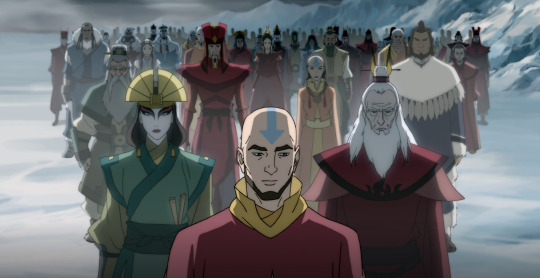
I cried.

100%.
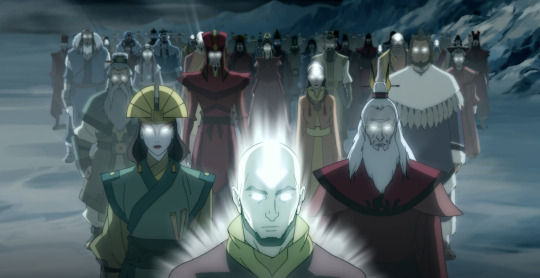
And the gentle, yet all too familiar Avatar theme playing in the background? Yeah, I was a puddle of tears.
However, as nostalgic as this was, I wasn’t too pleased at how quickly Korra’s bending was restored because it felt like the creators were taking shortcuts again.
For the record, I like that Noatak took Korra’s bending away (though I would have liked a more epic battle?), as it debunked the whole “the Avatar is invincible” concept. But, really? A quick touch of Aang’s fingers and her bending is restored, just like that?
Maybe it’s just me, but I would’ve loved to see Korra struggling to get her bending back. Perhaps we could’ve seen her retraining and relearning the other elements, which is something I still feel we were robbed of.
Furthermore, as much as I enjoyed seeing Aang and all the former Avatar reincarnations, I didn’t like that this was also the moment Korra connected with her spiritual side. Similar to her airbending moment, I forgot about her spiritual struggles; the issue is last mentioned in Chapter 8 and, before that, all the way back in Chapter 1. But, honestly, I think the ease and convenience of this moment lends to the problematic pacing of Book I as a whole.
Dear Creators,
While I thank you for restoring Korra and Lin’s bending, please don’t resort to convenient endings. I recognize that you only had twelve episodes, but please, no more shortcuts.
Your story will suffer.
Your characters will suffer, too.
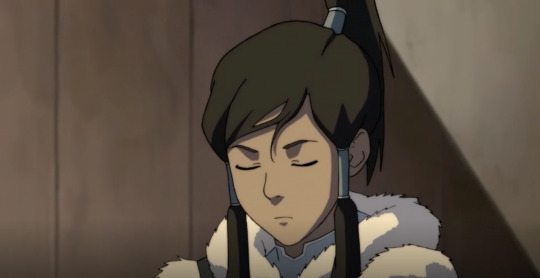
p.s., I’m sorry for being so mean to you. I have a lot of feelings, is all.
Cheers to Book II, though!
Parting Thoughts
Before sitting down to write the finale’s review, I took a two-week break.
In that time, I rewatched (and re-rewatched) the entire first book.
I even had time to indulge in the fifth season of The Great British Baking Show.
Shameless Plug:
I absolutely recommend this charming baking competition.
You learn quite a lot about the science and precision of baking, endure (but also adore) countless baking puns, and witness what true competition looks like. That is, genuine camaraderie, rooting for your fellow bakers to succeed, and sometimes, lending them a hand if they’re pressed for time.
Warning: do not watch late at night. You will reach for a baguette.
And yet, I still feel meh about Book I.
The season has its share of success: the music is as impeccable as ever and the technological and industrial components of the Avatar-Korra universe are developing and expanding nicely.
However, it will always come down to the story, and the writing just wasn’t up to par.
Truthfully, the real triumphs are the characters, who---after only twelve episodes---have built a home for themselves in my heart:
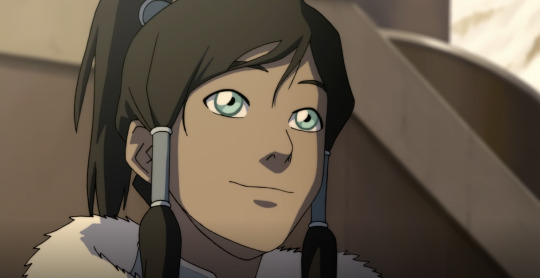

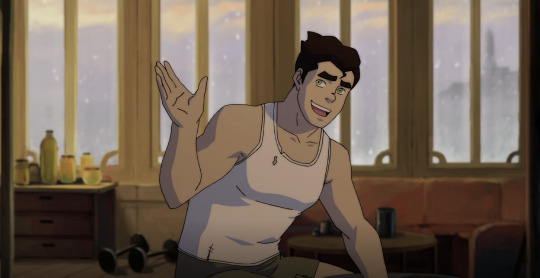
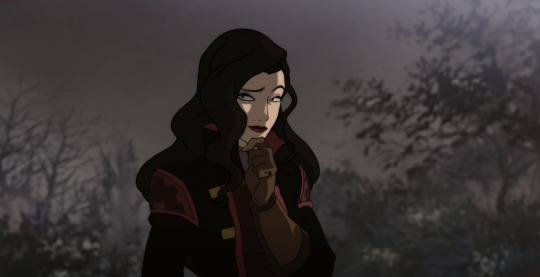
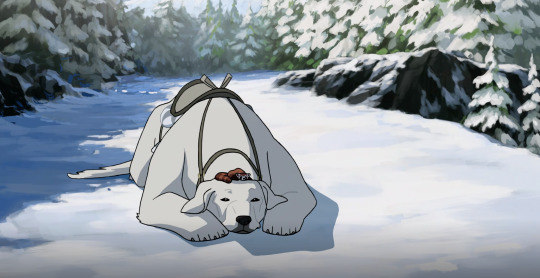
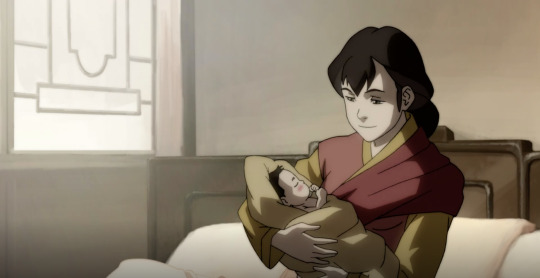


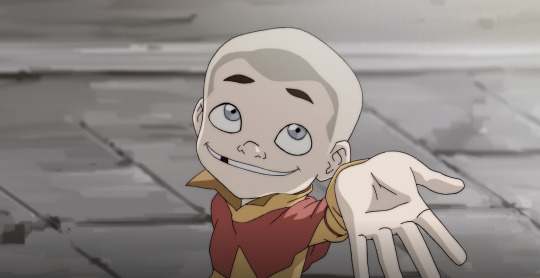
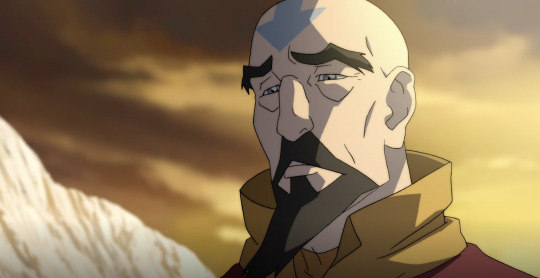

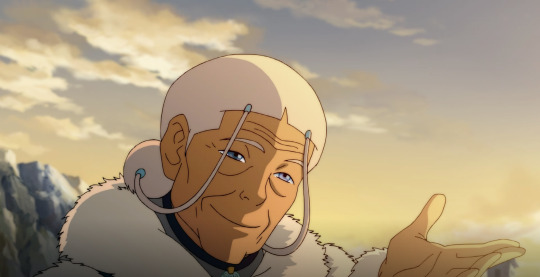
Although, our bright, blue-eyed Avatar still has much to learn.

(i.e., how to stop being an impatient little dumdum)

But take heart...
Her story’s only just begun.

From Beginning to End:
“Thanks for looking out for me, Aang.”

credits
1 note
·
View note
Note
I haven't listened to taz but I loved that Iroh thing you made up one time. So can you please do Iroh? Good luck with the next midterm!
Iroh’s incredible, good good choice, thank you for this prompt. This prompt got me through my midterms, actually, and through the first part of finals week. Thank you. And sorry it took so long to publish this – I take a glacial age to write anything, even these headcanon posts, but I did have a lot of fun doing it, and I hope you’re pleased with the result.
So. Let’s kick this off with the opening lines from that fic I’ll never write:
Iroh left the Fire Nation capital a proud general, filled with the passion of his element and the careless, easy confidence of those who have grown up blessed. In those days he laughed often, smiled at everyone, and dispensed kindnesses like a game. He rode to war at the head of a shining battalion, his son at his side and the whole world laid out at his feet.
He came back with white in his hair and age in his gait, at the head of a ragged company, with no one at his side but loss.
Iroh saved a dragon’s life. I will not budge on this, okay, I’m very invested in this headcanon. Slaying dragons was a big deal in the Fire Nation, remember – mastery over the element and nature or some such rot, bla bla honor, imperialism, whatever. Iroh’s the Dragon of the West for more reasons than one, and one of those reasons is that, as far as anyone knows, he slew the Dragon of the West. The last dragon left alive, people thought. Iroh told the story at parties for years – how fierce the battle, how fearsome the dragon, how fiery its demise. How the very mountains shook with its death throes. How absolutely certain he was that there were no dragons left, no sirree, not a one.
Iroh saved the dragon from another Fire Nation general. Some powerful firebender, one who’d lost his military command over some disgrace, was looking to regain his honor by slaying it, and Iroh stopped him. Killed him, which he can’t find it in him to regret, though sometimes he thinks maybe he should. Iroh turned away from his enemy’s burnt body and saw the dragon, wounded, dying, and learned a whole lot about dragon medicine on the fly.
Iroh wasn’t even looking for a dragon, which is the funny part – he was honest to god just passing through, yes I know it’s the middle of nowhere and there’s no human settlement for days, I really wasn’t looking for you, please don’t breathe fire at me I just want to help. Incidentally do you know the way to Sen Zhu, I am very lost.
Iroh doesn’t go to Sen Zhu for a while, because he has to nurse the dragon back to health, and after that it takes him to that dragon temple from the Indiana Jones episode. Iroh learns a bunch of cool firebending moves from the temple guardians, and when he leaves he swears he’ll tell the whole world that the Age of Dragons is over.
Iroh was a great general to serve under, back when he was still fighting. He has a brilliant tactical mind, and even before he learned how to be kind, he knew the importance of taking care of the people serving under you. His soldiers were well fed and provisioned, his officers didn’t abuse their power, and at night when they made camp he would go from campfire to campfire with a large jug of good wine and a choice selection of really bawdy jokes. It took a while for the soldiers to get used to this, but eventually they all knew him, and he knew them. By the time they reached Ba Sing Se, all of the soldiers, even the conscripted ones, had come to believe that maybe the Fire Nation would be in good hands when he took the throne.
He was a pretty great prince in a lot of ways. He was arrogant, yes, and prone to recklessness – you know the opening scene in Prince of Egypt, where the two princes wreck everything? That was Iroh and Ozai, every other month – but he was clever and cunning, he knew everything about how the Fire Nation was run, and he knew how to balance listening to wise counsel with making his own decisions. Everyone was sure he was going to be a strong Fire Lord, and most people thought he might even be the one to end the war. The general consensus was that the Siege of Ba Sing Se would be the last great battle of the hundred-year war, and that when it was done or shortly after, Azulon would step down and hand his crown on to his son.
When Iroh took Zuko under his wing, it wasn’t because he saw himself in Zuko. It wasn’t even because he saw his son in Zuko – that would have been too painful to bear, even several years after his death. It was because of how much of his family he didn’t see in Zuko. Where Iroh had been arrogant, Zuko was shy. Where Ozai was coldly ambitious, Zuko was generous and kind. Where the Fire Lord was dispassionate and calculating, Zuko cared about people. Where Azula was—well, the less said about Azula the better. But Zuko was nothing like her, and if Iroh had anything to say about it, he never would be.
Iroh met his wife in winter, under the boughs of the only tree in the palace gardens that blossomed in that season. Their marriage was not yet arranged, but they both knew it was likely to happen. She had smiled at him, shy and hesitant under the star-white flowers, and admitted with a self-deprecating smile, “I think I’m meant to seduce you.” Iroh had laughed, and said, “Our parents can worry about that. Why don’t we talk about something else? Do you like the theater? There’s an excellent production of Zukon the Dragon-Slayer on in town.”
After the play, they walked arm in arm through the city parks, under trees that were sparse and drooping in the tropical winter, and talked about dragons and history and storytelling, and never once touched on politics or weddings. It was only after several more months of such outings that Iroh turned to her, seriously, and said, “I know what our parents have planned, and it’s not a plan that I could ever object to. Spending time with you is the brightest part of my day. But I would rather work the rest of my life on forging alliances with your family myself than see you unhappy. If you don’t want the marriage to happen, it won’t. I will see to it that it won’t have to.”
They weren’t in love. They both knew this. But Iroh thought he could grow to love her, that he could be happy the rest of his days with her at his side. He hoped she felt the same, but—
She stared at him in shock, and then started to laugh. Iroh turned away, embarrassed and awkward, ashamed of his sentimentality. He didn’t see her face when she called him an idiot, and he was taken by surprise when she turned him around, still laughing, and kissed him.
Iroh joins the White Lotus like this: One of its members is the governor of an occupied Earth Kingdom city, and when Iroh visits, they play pai sho. Iroh leads with the white lotus tile, and the governor comments on what an unusual choice it is. Iroh responds with something cryptically philosophical, as he is wont to do – something about unexpected stratagems allowing for unpredicted victories. It is exactly the kind of thing White Lotus members say to each other.
They play a full game of pai sho, and Iroh wins, making use of clever strategies and maneuvers which are all part of the secret code that White Lotus members use to impart how much they know. Iroh’s new friend understands it all to mean that Iroh’s a super high-ranking member of the organization, and he’s here to help the governor with some problem plaguing the city.
Iroh’s never heard of the White Lotus. He’s just really good at pai sho. When the governor asks for help, he gives it freely, because that’s just who he is as a person. When word spreads and more people start coming to him for help, flashing a white lotus tile as they ask, he starts to put two and two together.
Iroh doesn’t tell anyone that no one ever actually recruited him, in case they decide to assassinate him or something. He picks up secrets as he goes, through intuition and careful questions. It’s not like he disagrees with what they’re doing, once he figures out what it is.
After the war, he tells King Bumi about all this, and they laugh together for a good long time.
Iroh and Bumi get along like a house on fire. Sometimes literally, because they have a lot of friendly duels and they can get a little out of hand. In the years after the war, they exchange lots of correspondence, and Iroh visits Omashu a lot.
Whenever he does, the whole city despairs, because now there are two unreasonably buff old men with mad bending skills walking around, delighting small children with their antics and imparting cryptic wisdom to shopkeepers.
Iroh never actually got a divorce. His father wouldn’t let him, and later his brother upheld that ruling – a disgrace to the throne, your wife leaving you because she can’t bear to see your face anymore. Because you can’t find words to say to her anymore. He never got a divorce, but he hasn’t spoken to his wife in a long time. She lives with her sister, on one of the more distant islands.
When Iroh was imprisoned in the start of Book Three, she sent him a letter. It was cold and brief, and Ozai had the prison guards read it to him, out of… some jealousy that still remained, some desire to see Iroh beaten, to see him brought as low as he could be brought. Iroh listened to it silently, eyes hooded and blank, which was how he always looked in prison when there was anyone around to see. In the letter, his wife said, “My heart is a barren winter, where only the star-white flowers of the senko tree could bloom. Hearing of your vile betrayal, you who style yourself Dragon of the West, I remember the dragon-slayers of old, and I long for a return to those days of chivalry and hope. The legacy of that time has died, but it pains me to think that we have fallen so far. I hope you still believe in repentance.”
After the war, he finds her. “Thank you for your letter,” he says. “Thank you for believing in me when no one else did. I am sorry for how long it’s been.”
“I meant what I said in it,” she says firmly. “I am your wife and your ally. I should have been by your side, these many years.”
“As I should have been by yours. I should never have left you to grieve alone.”
Iroh’s wife smiles, and kisses him on the cheek, and says, “Now, I think we should get down to business. Your nephew has the support of the people and of the Avatar, but that won’t keep him safe for long. I have a list for you of blackmail material for the nobility. Unfortunately it’s not comprehensive, but we’ve managed to assassinate or otherwise remove the worst ones in the chaos of the last year or two, so your boy should have a few years at least to solidify his claim.”
Turns out Iroh’s not the only one who’s been running with an undercover network of powerful people looking to enact change. Hers is smaller, based almost exclusively in the Fire Nation, but it’s also a fair bit more… hands-on. Iroh immediately takes her back to Zuko and says, “Nephew, hire this woman as your advisor. Trust me, you want her on your side.”
Iroh loves his brother. That never changed, even when Ozai stole the throne, abused his children, killed… no, surely Ozai would never kill his wife. Surely not. Iroh won’t believe it. But even so, Ozai has done horrible things, become a monster worse than their father, and Iroh loves him still. Iroh tries to reason with him, tries to fight him, and it never seems to make any difference. Iroh works against him, secretly, with the rest of the White Lotus, and his heart is heavy as he does.
Iroh sees his brother challenge Zuko to an agni kai when the boy is only thirteen years old, sees his brother mutilate his own son in public, sees the unrelenting rage in his brother’s face as he does it. Iroh gives up.
Iroh loves his brother. He never stops loving him, till the day he dies. But he never forgives him, either.
Iroh came home from the Siege of Ba Sing Se a broken man. That phrase gets thrown around a lot, to the point where it’s almost lost its meaning, but this is what it means here:
In the days after coming home, after kneeling before his father’s throne and recounting his defeat, Iroh does not leave his office. For seven days and seven nights he sits at his desk, staring at the books and scrolls that he’d studied before leaving. They’re filled with tactics, strategies, accounts of historical battles. He wants to burn every last one of them. He can’t muster up the energy.
On the eighth day his brother comes to his office and says that this has gone on long enough. The people are worried, his family is worried – it’s time for Iroh to leave his rooms and return to the world of the living. Iroh stares at him, stares through him, but Ozai doesn’t take no for an answer, forces Iroh to shower, get dressed, go outside. Iroh follows his brother through the halls of the palace like a ghost, empty and drifting.
“You’re upsetting your wife,” Ozai tells him. It’s one of many things Ozai tells him, but it’s the only one that sticks. Iroh hasn’t seen his wife since he came home, and told her that he sent their son marching to his death. She had known already, of course – he’d sent word when it happened – but she had thrown herself into his arms and sobbed until she was empty. Through it all, Iroh had held her and felt numb. His guilt and his grief had long since consumed him, until he no longer felt like a man at all, just a walking hole in the world.
The next day, and the next, and the day after that, Iroh forces himself to leave his rooms. He walks through the palace, face blank, not seeing any of the people who bow and step out of his way as he approaches, not hearing their hushed whispers as they stare and stare at their fallen prince. He walks, after a while, into the city, without a litter or a procession, unaccompanied by anyone but a squad of harried guards who were manning the palace gates when he went through and had to hurry to catch up. He stops in parks and at busy intersections, and spends hours watching the flow of traffic or the way the wind moves in the branches of blossoming trees.
This is very embarrassing for the crown. Ozai is sort of regretting having forced his brother out into the public eye. There are whispers and murmurs that the Fire Nation will surely crumble when Iroh takes the throne. Azulon is not pleased.
Iroh’s wife goes to live with her sister. When she tells him she’s leaving, he nods, and says, “I understand.” When she’s gone, he puts his head down in his arms and cries, for the first time in a long time.
It’s not long after this that Iroh goes before his father – formally, requesting an audience and kneeling before his throne – and asks permission to run away. He wants to tour the kingdom, he says. He wants to see the results of their war with his own eyes, to remind himself what they fought for. Azulon is relieved. He sends Iroh off with his blessing, hoping his son will find his backbone out in the world where he lost it.
Iroh wanders, for a long time. When he comes back he is, once again, a changed man.
#finx writes#finx has friends on the internet#uncle iroh#atla#I'm very pleased with this one#it's still not the fic I wish I could write but that last bullet point is basically the first chapter anyway#and it was definitely going to include the dragon scene#iroh makes friends with a dragon and it's awesome#he ends up an ally to the temple-keepers#they teach him a ton of cool new firebending stuff#new moves but also a new approach to the whole discipline#and from the dragon he learns a lot of new philosophy around fire and age and responsibility and time#guardianship of the land and spiritual connection with the world#also about his wife#I love her#I want only the best for her#so does iroh#and I admit it feels a little cheap to have her be a resistance fighter but it felt cheaper still to not figure out what she's been doing al#all these many years#and I rather think she would have fought against the fire lord#not just for the loss of her son - lots of people lost their children to this war#and not just for the insult to her husband when he took the throne#those might have made her angry but that's not enough to fuel a true rebellion#it was for how he led the people#how he built on azulon's authoritarianism and made it ever stronger#she'd seen nothing of the war before her husband and son went off to fight in it#she has no reason to see it now#but she sees what the war is doing to her own country; she sees that the war is here too#I think this is where she's found by some people who show her what war truly is - the death and miser and despair in the earth kingdom#and I think this is where she starts to fight back
113 notes
·
View notes
Text
Discover the Home Story
Orientation
The Backstory of the Fallen Goddess Scenario (FGS)
Nothing in nature is born without a birthplace and a matrix, its mothering entity. This law applies to microbes, animals, even the oceans and clouds. Likewise, no myth, metaphysical teaching, spiritual system, religion, ideology, work of art, or scientific theory comes into the world out of nowhere. Every event that confers self-understanding on the human species comes, not from “humanity” in an abstract sense, but from a particular locale in the world inhabited by a distinct racial strain. The Japanese creation myth, for instance, comes from the island of Japan and its native peoples. Aztec mythology arose from the landscape and mindset of the Meso-American peoples, the local tribes. The dominant belief-system in the world today, the trio of Abrahamic religions (Judaism, Christianity, Islam), came originally out of Canaan (modern Palestine) and spread across the planet from there.
The Home Story also has a specific geographic and racial origin. As you learn the narrative, it will be instructive to consider the backstory of the FGS — a term from filmmaking that describes the preceding conditions of a movie plot. This consideration is not required but it may be desired if you are an individual inclined to wonder about origins. The Home Story has a backstory like any other mythic narrative or religious system, any spiritual program you can name, such as Buddhism, Wicca, or Mormonism.
But there is a difference with this narrative, and it is huge. Due to its encompassing scope, the Fallen Goddess Scenario is a story to guide all the races of the world and even to describe the diverse roles they hold in what Gnostics today call “the divine experiment.” The Home Story differs from all other “creation myths” in the way it addresses the totality of the human situation, planet-wide, even though it arises from a specific geographic and racial origin. Its application is universal but it comes to the world as the product of the religious imagination of particular people.
So, before delving into the narrative, it may be worth while to give your attention to the following brief orientation.
The Sources
The sacred narrative of the Mysteries explains the cosmic origins of life and human purpose on earth, in a way not to be found elsewhere. No other body of myth or legend from any culture or epoch presents a “creation myth” as vivid, comprehensive, and coherent as this one. Likewise, no other narrative explains the ultimate truth about evil and how it works against all that is good and beautiful on our precious planet. The Home Story is the cosmic biography of the living earth. It is also the supreme heresy of all time.
Due to its exceptional message, this narrative has been attacked, distorted, maligned, and suppressed more violently, and more continuously over centuries, than any concept in all of history. Consequently, textual evidence of the FGS only survives in sparse and fragmentary form, like shards of a vast shattered mosaic. But it does survive.
The rare materials that preserve the myth of the Wisdom Goddess were discovered in the Middle East and Egypt. How then, can it be the guiding narrative of the Native European races? Also, since the myth comes from an ancient movement that originated in northwestern Iran (see below), how can it be designated as European at all? Against these objections, two points of clarification will be helpful:
First, those who developed this narrative came from the native stock of peoples whose homeland was in the Caucasus mountains. They were cousins to the Aryan-Celtic-Nordic-Teutonic-Italic-Iberian races who lived all over Europe. (Proof of this long-enduring kinship can be seen in the astonishing physical similarities between the Ossetian people of the Caucasus and the Celts of Ireland.) The authors of the FGS were ancestors of those diverse peoples designated at white, peoples who survive today as the racial minority in the world population: about 8%.
Second, the Iranian racial stock that produced the Home Story stood entirely distinct from the Arab-Asiatic peoples who inhabit Iran and neighboring regions today. And, of course, they lived long before those inhabitants were converted to Islam, or Christianity, or Judaism. Elsewhere around the Mediterranean basin and across Europe, from Greece to the British Isles, from Spain to Scandinavia, diverse peoples sprang from the same racial stock. The Home Story is the unique product of the religious imagination of Aryan Caucasians, a spectrum of races that originally and exclusively occupied the vast reaches of Western Europe and eastward as well, extending to Iran and into India, whose population contains a significant Aryan mixture.
The Sanskrit word Aryan comes from the Indo-European root, arya, “noble, excellent.” Not to say that only Aryans possess and express those qualities; rather, they exemplify the attributes of nobility and excellence to be attained by all races. That attainment, however, must be proven, demonstrated in values, attitude, and action.
A further question: Can counterparts of the Iranian version of the Home Story be found in European mythologies from Britain, Scandinavia, Greece, Germany, Italy, France, Spain and elsewhere? What about national epics such as the Kalevala of Finland, the rich trove of Greco-Roman mythology, Germanic folk-lore, or Irish, Welsh, and Basque legends? Looking back at those vanished cultures in their original pre-christian state of native purity, do you find any versions and variations of the Fallen Goddess Scenario? Do any of those sources offer a story based centrally on the figure of an earth goddess comparable to the Sophia of the Mysteries? Do they present in any way versions and variations of the Home Story such that it might be recovered and retrieved in those materials? Yes, they do, but those regional versions are chaotic, incomplete, and inconsistent. They do not present the entire plot of the narrative. Far from it. They are at best mangled variations. The European heritage only retains some random elements, names, incidents pertinent to the Home Story. Only partial features of the FGS, mere glimpses of it, can be found in the comparative myth, folk-lore and legend of Europe that survive today.
Why? Quite simply due to the fact noted above: the Home Story has been so relentlessly attacked that only scattered clues from it survive. Across Europe almost all evidence of it has been deliberately suppressed, placed under taboo, if not actively demolished. For example, Nordic myth does not offer a coherent rendering of the Sophianic narrative, nor even isolated episodes or extracts. Only a version of her name survives: Ostara. And that name is borrowed from the Germanic peoples whose mythological heritage likewise was demolished when Christianity overtook Europe. All that remains is the name, Ostara, without a single clear story-line about her. Without a clue to her origins and her continuing existence.
The Background
The FGS is not the work of a single human author. It was developed over many generations by the Magian Order, a community of visionary teachers. The Magians were the pagan, pre-Christian forerunners of the Gnostics. They called themselves telestai, “those who are aimed.” What aimed them? It was their intimate access to the intelligence of the living earth, the telluric matrix. In their united dedication to the sacred narrative of Sophia, they revised and preserved the Home Story over many generations. Their name for the Wisdom Goddess in ancient Persian was Spandarmat: expansive, vibrating mother, the measured web of life. This was the Iranian mother goddess known to the Magians, one of the earliest names for Sophia.
The “mother goddess” or “earth mother” is of course a universal archetype. Some version or another of that figure occurs in all indigenous, animistic societies in all lands. The Magian Gnostics detected this divine maternal figure in a living presence to be encountered and engaged. Animistic peoples who directly sense the presence of the living earth rarely go beyond that sensation into deeper dimensions of knowing. They remain emotionally captivated by that power, and are most often merely superstitious about it. The telestai were different. They blazed the trail into profound and intimate engagement with the intelligence of nature. They conversed directly with the mind of the planet. They were intellectual shamans highly accomplished in visionary practices, paranormal faculties, literacy, mathematics, astronomy, the natural sciences and art-forms such as music and dance. Accessing the mind of the living earth by a special method of trance, they were able to construct the FGS based on encountering the main character in the story, Sophia. Knowing the earth mother in such a penetrating way, they were able to construct a story about her unlike any other in its scope and detail.
The origins of the Magian Order date to 6000 BCE. Much later on, their beneficiaries, the Gnostics, inherited and preserved their narrative. Over centuries, they accomplished the complete narrative of today, the Home Story. The discovery in 1945 of books hidden in a cave at Nag Hammadi in Upper Egypt made it possible, after centuries of repression and destruction, to restore the full-scale coherent narrative of the Wisdom Goddess. Collated with other materials from European antiquity and Near Eastern myth, the Nag Hammadi Codices are the primary basis for recovery of the Sophianic myth.
The Mysteries
Volumes have been written about the Mysteries, Mystery-religions, or Mystery Schools of pagan antiquity. Unfortunately, attempts to explain this topic fail from the outset, due to lack of evidence of what actually occurred in those long-forgotten cultures. Honest scholars concur that the practices and procedures of the Mysteries are unknown, having been protected by a vow of silence. Not secrecy, silence. Unfortunately, again, those today who claim to know about the Mysteries often accuse their adepts of Satanic rites, mind control programming, and other sinister procedures. The Schools were “Illuminati think tanks,” as a popular meme asserts. This claim is totally untrue, and there is not a shred of evidence to support it.
Scholars agree that participants in the Mysteries accessed in some manner the deepest truth about human existence, going to the tap-root of life and consciousness. There is precious little evidence of how they did so, but there is enough to assert that Gnostics, the heirs of the Magian Order, were men and women of high intellectual achievement and spiritual vision. Skilled in shamanic arts, they were the guides and educators of the ancient world in the Near East, around the Mediterranean basin, and all across Europe — an assertion supported by ample and various evidence. The Mysteries were adapted bioregionally so that they met the needs of the local inhabitants, and matched their mindset and their specific talents and skills. And the leaders of the Mysteries went by different names reflecting the different languages spoken in each region. For instance, in Northern Europe the teacher was a Druid, meaning literally the oak-seer or tree-seer. Whereas in Egypt, the teacher was a phoster, meaning a light-bearer, an illumined one. Historical records show that the Druids of the British Isles actually conferred and met and mingled with the teachers of the great School of Alexandria in Egypt. In Scandinavia, the shamanic teacher was called Woden or Odin. This was not the name of a particular man, but rather a title of one who possessed clairvoyant powers, an accomplished shaman. In India, those members of the same Mystery network were called by various names, such as vidyadhara, meaning wisdom-holder, and siddha, accomplished adept, one who possessed and demonstrated occult powers. And there was many other variations of such names or honorific titles. All in all, the teachers of the Mysteries comprised a spiritual aristocracy, you could say. But it was a working aristocracy, dedicated to guiding humanity on its proper path of development. Their paramount tool of guidance was the Home Story.
The central figure of the Mystery Schools was the Wisdom Goddess, Sophia, known by names differing by people and region. Her name in Greek means “wisdom.” Philo-sophia was originally “love of wisdom,” and by extension, love of the goddess herself, known in her living presence. Due to their intimacy with her, the telestai had a lot of terms of affection for Sophia, such as Prunikos, “outrageous, daring, audacious,” and the Aramaic word hayyta, “who gives birth to life,” a play on heywa, “wise serpent,” and many others. (It is striking how the Aramaic heywa closely echoes the mother tree goddess of Avatar, Eywa.) Sophia was also known as Ostara and Spandarmat, as already noted. Among the Ossetians or Alani people of the Caucasus, she was called Satanaya. Among the Navajo of the American continent, Spider Woman, Changing Woman. Among the Aztecs, Coatlicue, Snake Woman. Among the Basque people, Mari, and there are hundreds of other variations of her name. Mystics who looked into nature with paranormal skill knew that the planet, which is too large to be seen entirely when you are on it, revealed itself in local phenomena, epiphanies or revelations coming through nature itself. Sophia revealed herself through animal powers such as the epiphany of Snake Woman. Her revelations came principally as snake and tree, but also as particular animals such as the bull, lion, panther, or birds such as the eagle, swan, and owl.
Gnostics today have reverential names for the earth mother: the Aeon Sophia, or the Aeonic Mother, the Divine Mother, World Mother or simply PAM, Planetary Animal Mother. Aeon is Greek for “generating power, god-force, divinity, supernatural creative energy.” Direct contact with the living intelligence of the earth afforded the teachers of the Mystery Schools with endless sublime discoveries. They learned secrets of the cosmic setting of life, terrestrial physics and human design, the myriad patterns of animal life, the living properties of sky and mountain, the miraculous awareness of bodies of water such as springs, streams, lakes and rivers. Among all these wonders they focussed intently on the presence and role of human animals in the cosmic order. They saw this role as being special and exceptional, yes, but not as being in some way superior to other forms of animal life or to nature itself. The scope of their detective powers, as you might call them, was vast. They also observed the effects of extra-biospheric intrusion upon the earth, known today as the ET enigma. The more they learned, the more thoroughly and meticulously they developed the Home Story.
There is perhaps one momentous teaching of the Mysteries that exceeds all others. The telestai realized that the divine presence of Sophia did not merely arise when the earth took form: rather, Sophia pre-existed the earth on the galactic level, as a star goddess. And equally astonishing is their assertion that Sophia did not create the earth, she turned into it. The origin of Sophia is in the galactic core. The Home Story is an astronomical myth.
Gnostics also taught about a supreme being, the Originator, who appears in the first Episode of the FGS. They did not use the routine religious syntax of “creation.” Instead, they explained by exhaustive writing and teaching about the cosmic process of emanation, or emergence, which resembles dreaming. In essence, they taught that the star goddess Sophia dreams the planetary body as someone asleep produces a dream body and so acts in that altered state, within the dream. Yet her “dream planet” is wholly material, sensorially and physically real. It is not “maya,” regarded as mere illusion (which, by the way, is a mistranslation of maya). The initiates of the Mysteries verified these discoveries over and over again in their shamanic practice of ecstatic trance. They saw no contradiction between reason and revelation. Gnosis is direct knowledge of the Supernatural that can be verified by reason based on evidence in the natural world and in the workings of the human psyche. It is what today is called noetic science, but in a superior form that does not exclude mystical and paranormal dimensions of experience. Guided by the sacred narrative, the initiates of the Mysteries developed what can be called “Gnostic intel” to a high level of sophistication. As they were aimed, so they strove in turn to aim the races, to guide humanity on the way to fulfil its inner endowment as a genius species. Their purpose and plan was higher education along spiritual lines. On that path they inspired their students beyond being mere passive inhabitants of the planet toward active engagement with the dreaming power that produced and sustains the human habitat. Such also is the aim of Gnosis today.
The legacy of the Mysteries today remains squarely based on the sacred narrative, the Home Story. The opportunity for all who learn the Sophianic vision story and choose to live in the narrative is an incomparable privilege: Participate in the dreaming activity of the Aeon Sophia so that you play an active role in the outcome of what she dreams. But that opportunity comes with responsibilities.
The Challenge
Ideologues of the three Abrahamic religions hate the Sophianic myth. And well they should, for it challenges their fundamental beliefs and answers many questions that otherwise must be left to faith. What’s more, it presents a narrative with the power to entirely overthrow their creation stories and render them useless and absurd. The heresy coming out of the Mysteries makes those faith systems look extremely stupid, and exposes the harmful deceit of blind faith. Gnosis presented in its time, and still presents today, a frontal threat to religious faith and its accessories, orthodoxy, authority, hierarchy, and most of all, moral rules said to proceed from the creator-god. Gnosis has always been the opposition movement to all belief-systems. It does not present an alternative religion, but an alternative to all religions.
Engagement with the Sophianic myth may be compared to film-making. Actors who play roles and deliver lines have to know the plot of the film. Others who appear in the film have no significant roles, and often no speaking lines. Their participation does not require knowing anything about the plot of the movie, far less about the intention of the director, screenwriter, and principle cast. These are the “extras,” comparable to NPCs, non-player characters in a video game.
By the Gnostic standard, to be ignorant of the plot of the Home Story is to be an extra in the dreamed scenario of the World Mother. What transpires in life as we know it is her movie, an event happening in her greater life as an Aeon, a cosmic-scale divinity. Learning the sacred narrative enables you to see a role for yourself in the plot of the spectacular film in progress. You win the role by owning your power to merge with her power — and by recognizing that you do live in a dream, though you are not the dreamer. But once you win the role, you have to act the part. You have to live your life with a clear sense of transpersonal direction, guided by the sacred narrative, aligned to the designs and purposes of the Wisdom Goddess. Living in that way gives you the optimal chance to express your innate talents and gifts as an individual person, and enjoy your role as a unique member somewhere in the spectrum of the human races. The transpersonal fulfils the personal. The personal cannot fulfil itself.
Conclusion
The most beautiful story on earth is the story about the earth, the sentient and intelligent mother planet. It can be called a vision story, not to be mistaken for a fantasy trip or a grandiose game of pretending. In fact, the Home Story totally demolishes the narcissistic claim that we are gods. Sophianic myth is light-years beyond New Age make-believe and is, in fact, the perfect antidote to it. The Home Story is a “meta-narrative” that you test and verify at every point of engagement with it.
There is some talk today about the need for a meta-narrative to unite good and honest folks in all lands who want to see the world turn for the better, and wish to be instrumental in that shift. The meta-narrative does exist, and must not be taken on authority. You can only believe the life-story of the World Mother to the extent that you live it for real. Those today who see the need for a meta-narrative face a dilemma. Would they be able to recognize it when presented to them? Perhaps they think they can construct a meta-narrative, a new myth. Good luck on that.
Comparative mythology is the comprehensive study of topics, themes, and characters found in the myths of all cultures over time. Without extensive skill in this genre, it is impossible to compare the FGS to other myths and determine its unique and outstanding properties. In short, it’s a professional call. Not to be taken on faith, however. Only in the perspective of comparative mythology do the exceptional features of the FGS become obvious. But once that observation has been made, the truth is there to see, independent of expertise. Verification of the myth depends entirely on first-person participation, living in the narrative. Certainly, the myth is complex and requires patience and intellectual determination to master. To put into practice the Sophianic myth relies on basic intelligence, but it also sharpens, enhances, and amplifies the mental effort brought to it. The dubious presumption of IQ is not an issue here. Participation relies merely on the will to learn.
What, finally, would attract anyone to become involved with this elaborate mythic narrative? Those who seek purpose in life will find both the frame and foundation for it in this visionary tale. That already is a huge factor of attraction, and there is more as well.
Gnostics taught that Sophia was compelled by overwhelming desire to plunge into the experiment conducted with the species-singularity she herself had designed, acting in the galactic core, the Pleroma. Participation in the Home Story begins with a natural feeling of empathy for the Aeon, your divine mother. In that empathy, you can realize how a superhuman divinity can be sentient like yourself, subject to emotions of joy, daring, terror, pleasure, confusion, grief — as the narrative fully describes. That being so, you can no longer think of the earth as a gigantic rock floating in a cosmic void. No, Sophia is alive, intelligent, emotively responsive, self-conscious of her planetary body, and co-active with all that lives, especially with human animals.
The Sophianic myth has many dimensions of meaning and applications to life. The summation of Sophia’s myth converges and dwells on a point of esthetics: as nature is beautiful, so is the supernatural source of the natural world. But infinitely, inconceivably more so. The natural world is lovely and bountiful in countless ways, Likewise, the World Mother, the dreaming goddess at its source, but infinitely more so. Coming into Sophia’s immediate presence learning the spectacular star myth about her, you will realize that this particular cosmic divinity is all about esthetics.
The most beautiful story on earth is the story about the earth. Finally, or perhaps from the outset, there is one paramount factor that brings you home to the Home Story, and compels you to get involved and do your part to determine its outcome: that factor is beauty.
1 note
·
View note
Text
Take a View at the State of the Art iPhones
Customers probably concur with me that iPhone X layout was one of the very best, and that is precisely why Apple chose to keep the exact same look for their next pair of personal cell phones.
Introduced a year ago, it is the very first Apple smart phone to remove the main button. In the other, I held its brand-new successor, the iPhone Xs. My eyes squeezed closed, and I passed them back and forth between my hands, rolling each phone over, feeling the curves, glass backs, dual lens camera lumps, and radar vents. I realized I could not tell the difference between both phones. This is not a criticism. It is just a fact of S model years, where Apple locks in the iPhone layout and concentrates, instead, on upgrading key internal parts. As such, the biggest changes to this 5.8-inches iPhone Xs and its big brother, the 6.5-inch iPhone Xs Max, both of which I tested, could be discovered in performance (thanks to the newest A12 Bionic CPU), photos and videos, (new digital cameras and a new ISP endorsed by the A12), along with functionality (iOS12, the final version of which came pre-applied on my test components ).
The outcome is a pair of brilliant, tasteful, and high-performing gadgets which can please iPhone enthusiasts and receive over a couple of looks in Android cellphones.
It has the exact rigid surgical metal frame wrapped into a fresh glass substance that Apple said was formulated to be scratch tolerant and heavy duty. I gave the phones a few half-hearted drops onto a thin-pile rug but was not prepared to let them slide away on concrete. Thus far I have discovered just one very nice scratch on your iPhone Xs Max. So let's consider them scratch-resistant, but still not scratch-proof.
The larger iPhone Xs Max shares all of the iPhone X's content and layout attributes, but does this in a 6.2-inch x 3.05-inch x 0.30-inch body.
In 208 g, it's much thicker than the iPhone Xs.
The Xs Max is a hair shorter (0.04 inches) and narrower (0.02 inches), but it is also a few grams heavier than the Iphone 8 Plus, the big-screen phone that from a space the Iphone Xs Max most resembles.
Button positioning power/sleep, volume controls, ring/silent switch -- will be the exact same. But, there is one minor chassis gap. On the bottom edge of the telephones sits the lightning connector. It is book-ended by a pair of holes that adapt one half of their stereo speaker system and one of the telephone's microphones. There was six holes on both sides. Now the ideal side has six slots, but the left, which just houses a mike, has just three. This little change was done, in part, to adapt the new internal antenna setting that contains 4x4 MIMO and License Assisted Access, which utilizes unlicensed 5 GHz spectrum to deliver 1 Gbps broadband over LTE.
Apple updated the water and also dust-resistance rating to IP 68, that contrasts to the handsets surviving in 2 meters of water for as much as half an hour. I didn't get to go swimming together with the Iphone Xs or even Xs Max, but did operate the latter phone under water, juice and milk. Then, as recommended, I dried and shut off the smart phone. I was careful not to plug it into a lighting cable (that is a no-no after a dowsing) but did place it on a wireless charging foundation at which it had no trouble accepting a fee.
Apple, incidentally, said it put some work in creating the wireless charging platform (basically the concealed coils within the phone) more forgiving. This is good news, because I've on more than one occasion, awakened to find my iPhone X didn't charge because I placed it a little off-axis on the charging base. I never ran into this issue with either the iPhone Xs or even Xs Max.
The Iphone Xs and iPhone Xs Max bodies are rigid and robust-feeling, but torqueable, especially the larger telephone, which really makes a tiny clicking sound when I attempt to twist it. Clearly, I have only had those iPhones for weekly, but based on a calendar year's encounter with the first iPhone X (allowed, largely in a sparse instance ), I consider this design framework tough and prepared for the long haul.
Even as Samsung trolls Apple to its black cutout at the top of this Iphone Xs and Xs Max, Apple reveals no clues of moving back in the multi-feature technology, which grew nor slipped in the hottest iPhones.
As with the first TrueDepth Module, that one is still packed with the same elements (none of that, so much as I could tell, have been updated). There is a 7 MP camera, dot projector for thickness sensing, infrared camera (thickness sensing), flood illuminator (yes, too for depth-sensing), proximity sensor, ambient light detector, the second half of the stereo speaker program, along with a mic.
On the backs of both the Iphone Xs and Xs Max, there is more of the custom made glass, the Apple Logo, the word Iphone (but no"X" or"s"), along with also the 12 MP dual camera system. This vertically-oriented, pill-shaped camera module appears exactly the same as it did to the last iPhone X. It's still a prominent bump, but at least it did not get any bigger. Within the module is new hardware supported by new picture technologies, but more on that later.
I have always thought that the 5.8-inch iPhone X an excellent tradeoff between a big-screen phone and hand-friendly ergonomics. The screen is big and immersive, however, the human body is comfortable to hold and pocket. The iPhone Xs Max by contrast can, particularly if you're utilized to holding a smaller phone, feel large. It is not embarrassing to hold, but people with smaller hands will probably struggle with one-handed usage and will most likely wish to turn on Reachability, which having a swipe back on the flat bar moves everything halfway down the screen, which makes it longer reachable.
Nonetheless, the trade-off could possibly be well worth it. I forgot how much I like the bigger iPhone screen, and on the iPhone Xs Max, you receive a lot more display without contending with a larger phone (there's just that 0.04-inch height difference between the iPhone 8 Plus and the iPhone Xs Max).
Apple's full-stack control of the Iphone design, development, and manufacturing process pays dividends throughout the gleaming handset. Nonetheless, it's most noticeably from the silicon, which can be created and designed in tandem with the hardware and software elements that will rely on it.
This past Year, Apple delivered the A11 Bionic, a powerful portable CPU with built-in Artificial Intelligence Power. The brand new A12 Bionic assembles on this brief legacy having a more strong Neural Engine and much more impressive graphics functionality.
Anytime I critique a new iPhone, I begin using Geekbench 4 to check out the raw CPU operation. To ensure there are minimum background processes moving, I usually run the exam before I have set up one program. I conducted the Geekbench CPU routine and (along with understanding that Apple stuffed an additional gig of memory inside the brand new Xs class iPhones) saw the only core scores had improved somewhat between the A11 Bionic along with A12 Bionic. On the other hand, that the multi-core score was strangely lower. Not by a lot, but I had never seen that occur. The numbers were much higher than what I got from Qualcomm's Snapdragon 845, however a decrease effect on the new iPhone did not make sense. However, when I reran the Geekbench CPU test per day or so after, the A12 multi-core numbers defeat those of the A11. My guess is that, even though I set up the iPhone Xs and Xs Max as fresh iPhones, there might nevertheless have been a background installation process going on that dragged down the CPU numbers.
The bigger leap in functionality is from the Geekbench Compute Metal score, which leapt from 15,145 on the iPhone X into 22,245 about the Iphone Xs and Xs Max. Apple's done a great deal of work to beef up images performance, especially for the raft of ARKit 2 (and Metal 2) software heading into the platform, some of which can support multiplayer gambling. While there aren't a lot of ARKit 2 programs in the app shop, I'd get some hands-on time using an Iphone Xs running Galaga AR, the identical demo Apple showed off throughout the iPhone Xs unveiling.
To play with, me and a few other writers stood about a desk and pointed out our phones at the Galaga video arcade game console. Shortly, alien attackers began streaming first from the video game display and then from all around us. I swung the telephone from side-to-side up and up and down to view and then take the incoming assault. It was fast-paced and cool.
In the same way, I have seen , together with ARKit two, the phone can place, say, an incredibly realistic virtual pressure stove or sneaker to a real table or in my feet, the illusion divided only once I slid my hand into the frame and, even about the iPhone Xs screen, it looked just like my notes had been stuck beneath the kettle. You can not support these types of real-virtual mixes without ample graphics horsepower, thickness mapping, and the AI needed to identify the way surfaces, shadows, and even reflections will work on virtual items in an actual space.
This processing power also helped amp up more ordinary operations such as Face ID. While the process of registering my face was unchanged from the first iPhone X, opening either telephone with my head, as well as using Face ID to access password-protected apps and solutions, is clearly quicker than it had been on the iPhone X.
In general, in real-world programs, both iPhone Xs and Xs Max operate smoothly.
Apple place tremendous effort into enhancing the picture and video experience to the Iphone Xs and Xs Max. Along with new lenses along with a larger detector, both the cameras (rear and selfie) are all backed with a brand new image signal processor.
The specs on the dual cameras have been untouched by the iPhone X (and would be the exact same on both iPhone Xs and Xs Max). There is the 1.8 wide angle lens and the f 2.4 2X telephoto. Both comprise optical image stabilization and may shoot up to 4K video in 60 fps. They still take slow-motion video at up to 240 frames per minute. If you want insane 960 fps super-slo-mo, then you will have to visit Samsung.
From the pure-play digital photography race, even however, Apple requires the head. The Smart HDR uses detector, ISP, and neural enhancements to catch some of the greatest high-dynamic range photos I've ever seen. The difference between what was possible on the first iPhone X along with the Xs and Xs Max is stunning.
Apple built a system able of capturing two frames every thirtieth of a moment, and instantly assessing and combining them into one image that preserves not only foreground and background detail, but can freeze actions without presenting tremendous grain. In many images, I saw the iPhone Xs and Xs Max find colour and detail in shadowy spaces with out wasting out the brighter locations. The Samsung Galaxy Note 9 is also an outstanding low light shot, however I feel the Xs line is a bit better.
I am particularly impressed by how Apple's built upon its own pole position in Portrait Mode digital photography. Apple introduced Portrait Mode back in 2016 with all the iPhone 7 Plus (the applications lagged from the hardware). Since then, Apple's elegant the concept, adding things like Studio Light, Contour Light, Stage Light, and Stage Light Mono. All these features remain, and are somewhat improved. That which I love and also, as an amateur photographer who often plays with f-stops for just the ideal depth of field change, is that the brand new Depth Control.
Depth Control enables you to take a Portrait Mode photo and adjust the Bokeh, or depth of field focus, after you shoot the photos. This works with both the front and rear cameras, which means that the image processor is using two distinct sorts of depth information. On the back, it has the advantage of two lenses to become stereoscopic info. The leading camera counts on the depth-sensing components.
I am aware of, Samsung's Galaxy Notice 9 provides the capacity to correct background focus while you're taking the image, in addition to after. But, there's an essential difference here that is evident in the iPhone Xs and Xs Max Depth picture editor. It is a slider that lets you adjust smoothly from an electronic f 1.4 aperture into a digital f16. In a real camera with a mechanical aperture, even high amounts interpret to sharper focus in the backdrop and reduced numbers imply the focus depth is much shallower. About the Galaxy Notice 9, Live Focus basically sees the images as two planes: the foreground and background. The slider blurs the background airplane. The Iphone Xs's depth slider relies on all of the depth information to reduce or enhance background attention through all of the airplanes between the front of this subject and the desktop. Combined with the improved Portrait Mode stitching (handling how the subject and a blurred background match together), the subtlety of this effect through the array of virtual f-stops is impressive and, Apple's explained, is modeled by how actual lenses with hardware apertures would influence each image.
For most people the smart phone is their camera. This sets a pro-level controller in the hands of millions of individuals, that are about to start taking some genuinely fantastic face pictures.
Just after taking regular shots, video, and 4K, I remain surprised with the quality of photos and videos coming from their Iphone Xs and Xs Max. Sure, it is odd that the larger Xs Max does not, as could be tradition, have some improved image capturing attributes, however I doubt anyone is going to be dismayed with the picture quality delivered by either new smartphone.
There are a couple of other hardware-related improvements, like the guaranteed dual-sim technologies that enables multiple phone numbers (believe work and individual numbers of one telephone ) through the aid of eSIM technologies. Unlike routine SIMs, you don't need a carrier card solely for the provider to support it and enable it on your cell phone. It's a wonderful feature that, for obvious reasons, I couldn't test.
For audio enthusiasts, there's also the newest stereo recording and also wider-stereo playback. This is just a bit hard to check, and that I occasionally worry my ears are not adequate to detect what might be a more nuanced difference. But, I'd find a way. I listed , in landscape style, a few cars traveling by. These start on the left side of this screen and push to the rightside. In movie I recorded with the iPhone Xs, the noise travels from one side of the telephone to the other. Playback on the iPhone X is pretty loud however does not have the identical level of separation audio.

Clearly, movies with a lot of sound engineering aren't only great showcases for the amazing displays, but highlight the new, wider stereo playback abilities as well.
As hardware/software partnerships go, you can't do better than the Apple iPhone Xs and iOS 12. I have been operating betas of their new portable OS for months on my iPhone X and found it impressively smooth and stable. On the Iphone Xs and Xs Max, it gets even better partners. In addition to butter-smooth and lighting rapid operation (in games, video, and internet browsing), the augmented reality abilities introduced in iOS 11, ARKit, and the iPhone X are more refined and customizable from iOS 12 along with the Iphone Xs.
The smart assistant is a better listener than ever, and getting smarter. Her speech is more conversational and she's requesting follow-up questions. Siri can be more proactive, discovering connections between disparate items such as schedules and locations and offering them in advance. Additionally, there are a variety of third party programs tapping into Siri, letting you use only your voice to get program attributes and data without even opening the app.
You are able to install iOS 12 on your old iPhone (down to this Iphone 5s), however not all of attributes, especially those between AR, will work on the older devices. Still, I greatly recommend the upgrade with at least anyone operating an iPhone 7 and up. It is simply a much better, more glossy, proactive, and smart user experience and, to be fair, I've barely scratched the face of all the upgrades and feature enhancements you'll find.
Apple asserts 30 minutes more battery life involving the Iphone X and Xs and 90 minutes more with all the Iphone Xs Max. In my experience, both brand new phone will get you through the majority of the afternoon on a single charge. I spent using just the iPhone Xs Max. this article I kept the brightness high and ran all kinds of apps and processes. It lasted just a solid 10 hours. Maybe a bit less than I expected, but still enough for me through the majority of the working day.
In all honesty, with less than a week under my belt, it's difficult to offer a complete evaluation of battery life performance. There are many factors and, clearly, battery life is going to be good on brand new phones. Talk to me in 6 months or 1 year, and we're going to see if I'm still happy with battery life.
It is not strange that Apple didn't bring down the cost for the brand new $999 Iphone Xs (or hold on the original model and market it at a lower cost ). I'm not even shocked that we finally have an almost $1,100 model or that we're able to pay a whopping $1,449 for the 512 GB Iphone Xs Max (which appears to be the version that I tested). Apple's already demonstrated that individuals will pay virtually anything to get their hands on the newest iPhone. Is $1,000 or more to cover a smart phone? Perhaps, however a lot of us think of the entire cost as opposed to monthly payments? I am, however, a little annoyed that Apple stopped the lightning -to-3.5 millimeter adapter. It is as if, in the past 12 months, we have gotten rid of the Beats and Bose headsets, such as it is a solved problem. Memo to Apple: It is not.
What I will say is that these are the iPhones you want. The iPhone Xs does not mess with what I consider a timeless design, and the Xs Max only takes all that is amazing about the iPhone X also enlarges it. As a set, they are equally as beautiful as the original home-button-free Iphone X. The design appears particularly tasteful in a golden finish. Photographers will love the new camera, and also players and content customers will want the big-display iPhone Xs Max.
Should you currently own the iPhone X, I still would not update unless you need more realistic augmented reality and also full depth control on your own portraits. For iPhone 6s, 7, 8, and even 8 Plus officers, the iPhone Xs and Xs Max will certainly feel as a giant leap to the foreseeable future.
0 notes
Text
Apple's New iPhones are Simply Superior
Assuming, like myself, you appreciate the original iPhone X design, which got rid off the single button and prolonged the amazing OLED screen to virtually all the edges, the iPhone Xs is not going to disappoint you.
Presented one year before, it is the very first Apple handset to jettison the single button. In the other, I held its brand new successor, the iPhone Xs. My eyes squeezed closed, and I passed them back and forth between my hands, rolling each phone above, sensing the curves, glass springs, double lens camera lumps, and lightning ports. I realized that I could not tell the difference between both phones. This isn't a criticism. It's just a fact of S design years, where Apple locks in the iPhone layout and concentrates, rather, on upgrading key internal parts. Therefore, the biggest changes to this 5.8-inch Iphone Xs and its big brother, the 6.5-inches iPhone Xs Max, each of which I tested, could be discovered in performance (thanks to the newest A12 Bionic CPU), photos and movies, (new digital cameras and a new ISP endorsed by the A12), and functionality (iOS12, the final version of that came pre-applied in my test components ).
The outcome is a set of fantastic, elegant, and high-performing handsets which can please Iphone aficionados and receive over a few looks out of Android devices.
It has the exact same rigid surgical metal frame wrapped into a new glass material that Apple said was formulated to be scratch resistant and heavy duty. I gave the phones a couple half-hearted drops onto a thin-pile carpet but wasn't prepared to allow them to slide away . So far I've discovered just one very fine scratch on the iPhone Xs Max. So let's consider them scratch-resistant, but still not scratch-proof.
The bigger iPhone Xs Max enjoys all the iPhone X's content and design attributes, but does so at a 6.2-inch x 3.05-inch x 0.30-inch human anatomy.
At 208 grams, it's substantially thicker than the Iphone Xs.
The Xs Max is a hair shorter (0.04 inches) and narrower (0.02 inches), however, it is also a few grams bulkier when compared to the Iphone 8 Plus, the big-screen cellphone that from a distance that the iPhone Xs Max most looks.
Button positioning power/sleep, volume controllers, ring/silent change -- are the exact same. However, there is one minor chassis gap. On the bottom edge of the telephones sits on the lightning connector. It's book-ended by means of a pair of holes that adapt one half of the stereo speaker system and one of their mobile's microphones. There used to be half a dozen holes on either side. Now the right side has six slotsbut the left, that only houses a mike, has only three. This small change was completed, in part, to accommodate the new internal antenna configuration that includes 4x4 MIMO and Permit Assisted Access, which utilizes unlicensed 5 GHz range to provide 1 Gbps chip over LTE.
Apple upgraded the water and also dust-resistance evaluation to IP 68, which translates to the handsets residing in two inches of water for as much as half an hour. I did not have to go swimming together with the iPhone Xs or Xs Max, but didn't operate the latter phone under water, milk, and juice. After that, as recommended, I rinsed and dried off the cellphone. I was careful not to plug it back into a lighting cable (that's a no-no after a dowsing) but didn't put it onto a wireless charging base where it had no difficulty accepting a fee.
Apple, by the way, stated it put some effort in making the wireless charging system (basically the concealed coils within the phone) more pliable. This is very good news, because I have, on more than 1 event, woken up to discover that my iPhone X did not charge since I put it a tiny off-axis about the charging base. I never ran into this issue with either the iPhone Xs or Xs Max.
The Iphone Xs and Iphone XS Max bodies are rigid and strong-feeling, but torqueable, especially the bigger phone, which really creates a tiny clicking noise once I attempt to twist it. Apparently, I've just had those iPhones for weekly, but based on a year's encounter with the original iPhone X (allowed, largely in a sparse case), I consider this layout framework tough and ready for the long term.
Even now as Samsung follows Apple for the dense black cutout near the peak of this iPhone Xs and Xs Max, Apple shows no signs of stepping back in the multi-feature technologies, which grew nor shrunk in the latest iPhones.
Much like the original TrueDepth Module, this one remains packed with the very same elements (none of that, as much as I can tell, have been upgraded ). There is a 7 MP camera, dot projector for thickness sensing, infrared camera (thickness sensing), flood illuminator (yes, too for depth-sensing), proximity detector, ambient light sensor, the second half of the stereo speaker system, along with a mic.
On the backs of both the iPhone Xs and Xs Max, there is more of that custom glass, the Apple Logo, the term iPhone (although no"X" or"therefore"), along with the 12 MP dual camera program. This vertically-oriented, pill-shaped camera module looks exactly the same as it did about the past Iphone X. It is still a prominent bulge, but at least it didn't get any bigger. Inside the module is all new hardware backed by new image technologies, but more about this later.
I have always thought that the 5.8-inch iPhone X an excellent tradeoff between a big-screen phone and hand-friendly ergonomics. The screen is large and immersive, but the human body is more comfortable to hold pocket. The iPhone Xs Max in contrast can, particularly if you're utilised to holding a more compact mobile, feel big. It's not embarrassing to hold, however people with smaller hands will fight with one-handed use and will most likely wish to turn Reachability, which with a swipe back on the horizontal bar moves everything halfway down the display, which makes it more accessible.
Still, the trade-off could be worth it. I forgot just how much I like the bigger Iphone screen, and on the iPhone Xs Max, you receive much more screen without contending with a bigger phone (there's just that 0.04-inch height gap between the Iphone 8 Plus along with the Iphone Xs Max).
Apple's full-stack control of this Iphone layout, development, and manufacturing process pays dividends during the handset. Nonetheless, it's most clearly in the silicon, that is developed and designed in tandem with the software and hardware elements that will rely upon it.

This past Year, Apple revealed the A11 Bionic, a powerful cellular CPU with internal Artificial Intelligence Power. The brand new A12 Bionic assembles on that brief legacy with a more strong Neural Engine and even more impressive graphics performance.
Every time I examine a new iPhone, I begin by using Geekbench 4 to check out the raw CPU performance. To ensure that there are minimal desktop processes going, I usually run the test before I have set up one app. I conducted the Geekbench CPU benchmark and (along with understanding that Apple stuffed an extra gig of memory in the new Xs course iPhones) saw that the only core scores had predictably improved marginally between the A11 Bionic along with A12 Bionic. On the other hand, the multi-core score was strangely lower. Not by a lot, but I hadn't ever seen that occur. The amounts were much higher than what I got from Qualcomm's Snapdragon 845, however, a decrease result on the brand new iPhone didn't make sense. However, once I reran the Geekbench CPU evaluation per day or so after, the A12 multi-core numbers beat those of the A11. My guess is that, even though I put up the Iphone Xs and Xs Max as new iPhones, there may still have been some background setup process happening that hauled down the CPU amounts.
The bigger leap in performance is in the Geekbench Compute Metal score, which leapt from 15,145 on the iPhone X to 22,245 on the iPhone Xs and Xs Max. Apple's done a lot of work to beef up images performance, particularly for the raft of ARKit 2 (and Surface 2) applications heading into the stage, some of which will support multiplayer gambling. When there are not a great deal of ARKit 2 apps in the app shop, I'd get a hands-on time using an Iphone Xs operating Galaga ARthe same demonstration Apple showed off throughout the Iphone Xs unveiling.
To play with, a few other journalists stood around a table and pointed our telephones at the virtual Galaga video arcade game console. Shortly, alien attackers started streaming from the movie game display and from all around us. I swung the telephone from side-to-side and up and down to see and then shoot the incoming attack. It had been fast-paced and fun.
In the same way, I have seen how, with ARKit 2, the phone can place, say, an incredibly realistic digital pressure cooker or sneaker to a true table or at my toes, the illusion divided only once I slid my hands into the frame as well as about the iPhone Xs screen, it seemed just like my digits were stuck under the kettle. You can not encourage these kinds of real-virtual mixes without ample images horsepower, depth mapping, as well as the AI necessary to identify surfaces, shadows, and even reflections will work on virtual items in an actual environment.
That processing power also helped amp up more ordinary operations such as Face ID. While the process of registering my face was unchanged from the first iPhone X, opening either phone with my head, in addition to utilizing Face ID to access password-protected apps and solutions, is clearly quicker than it had been on the iPhone X.
In general, in real world programs, both iPhone Xs and Xs Max work properly.
Apple place enormous amount of work into enhancing the photo and video experience on the iPhone Xs and Xs Max. Besides brand new lenses and a larger detector, the cameras (rear and selfie) are backed with a new picture signal processor chip.
The features on the dual cameras are untouched from the iPhone X (and will be the same on either iPhone Xs and Xs Max). There's the f 1.8 wide angle lens and also the 2.4 2X telephoto. Each of those comprise optical image stabilization and may shoot around 4K video in 60 fps. They still take slow-motion video in up to 240 frames per second. If you want mad 960 fps super-slo-mo, you will need to look to Samsung.
In the pure-play photography race, even though, Apple takes the head. Its Smart HDR uses detector, ISP, and neurological enhancements to catch some of the very best high-dynamic range photos I've ever seen. The gap between that which was possible on the first iPhone X and also the Xs and Xs Max is stunning.
Apple produced a system capable of shooting a couple frames every thirtieth of a moment, and instantly analyzing and blending them into a single image that preserves not only foreground and background detail, but that can freeze action without presenting enormous grain. In many pictures, I found that the iPhone Xs and Xs Max find color and detail in shadowy spaces without wasting out the brighter areas. The Samsung Galaxy Notice 9 is also an fantastic low light shooter, however I feel the Xs lineup is a bit better.
I'm especially impressed by how Apple's built upon its own pole position in Portrait Mode photography. Apple created Portrait Mode back in 2016 using all the iPhone 7 Plus (the software lagged from the hardware). Since that time, Apple's elegant the concept, including things such as Studio Light, Contour Light, Stage Light, and Stage Light Mono. These attributes remain, and are marginally enhanced. What I love and also, as an amateur photographer who often plays with f-stops for just the perfect depth of field effect, is the newest Depth Control.
Depth Control lets you take a Portrait Mode photograph and adjust the Bokeh, or depth of field attention, after you take the photos. This works with both the front and rear cameras, meaning that the image chip is using two unique sorts of thickness details. On the rear, it's the benefit of 2 lenses to acquire stereoscopic information. The front camera counts on the depth-sensing equipment.
I know, Samsung's Galaxy Note 9 gives the ability to correct background attention while you're shooting the image, as well as after. But, there's an essential difference here that's evident from the iPhone Xs and Xs Max Depth editor. It's a slider that allows you adjust easily from an electronic f 1.4 aperture into a digital f16. In a true camera with a mechanical aperture, the high amounts translate to sharper focus from the background and lower numbers mean the focus depth is a lot shallower. About the Galaxy Note 9, Live Focus basically sees the images as two airplanes: the foreground and background. The slider blurs the background airplane. The iPhone Xs's thickness slider is based on all the depth advice to reduce or enhance background focus through all of the airplanes between the front of this subject and the background. Along with the improved Portrait Mode stitching (tackling how the subject and a blurred background match together), the subtlety of this impact through the selection of virtual f-stops is impressive and also, Apple's explained, is modeled by how actual lenses with hardware apertures would impact each picture.
For the majority of people the smart phone camera is their camera. This places a pro-level controller from the hands of huge numbers of people, that are just about to begin taking some truly impressive portrait pictures.
Immediately after taking hop over to this web-site , video, and 4K, I continue to be impressed with the quality of videos and photos coming from this Iphone Xs and Xs Max. Sure, it's odd that the bigger Xs Max does not, as would be tradition, have some improved image capturing features, however I doubt anyone is going to be dismayed with the image quality delivered by either innovative smart phone.
Right now there are a few other hardware-related improvements, like the guaranteed dual-sim technologies that permits multiple phone numbers (think work and personal numbers of one phone) via the aid of eSIM technology. Unlike routine SIMs, you don't need a carrier card solely for the carrier to confirm it and enable it on your cell phone. It is a nice feature which, for obvious reasons, I couldn't test.
For audio enthusiasts, there's also the newest stereo recording and wider-stereo playback. This can be just a bit difficult to check, and I occasionally worry my ears aren't good enough to notice what could be a more nuanced difference. But, I'd find a method. I listed , in landscape mode, a few cars traveling by. These begin on the left side of the screen and push to the rightside. In movie I recorded using all the iPhone Xs, the noise travels from one side of the phone to the other. Playback on the iPhone X is pretty loudly however lacking in the identical amount of separation sounds.
Obviously, pictures with a great deal of sound technology aren't just great displays for the amazing screens, but emphasize the brand new, wider stereo playback capabilities as well.
As hardware/software unions go, you can not do much better than the Apple iPhone Xs and iOS 12. I've been running betas of this new mobile OS for weeks on my iPhone X and found it incredibly smooth and stable. About the Iphone Xs and Xs Max, it becomes even better spouses. In addition to butter-smooth and light fast operation (in games, video, and internet browsing), the augmented reality skills announced into iOS 11, ARKit, and the iPhone X tend to be more polished and custom-made in iOS 12 and the iPhone Xs.
The intelligent assistant is a better listener than ever before, and becoming smarter. Her speech is more conversational and she is asking follow-up questions. Siri is also more hands-on, putting connections between disparate items like schedules and locations and presenting them beforehand. Additionally, there are a range of third-party programs tapping into Siri, allowing you to use only your voice to access app attributes and information without even opening the program.
You are able to set up iOS 12 on your old Iphone (down to this Iphone 5s), however not all of features, especially those involving AR, will operate on the old devices. Still, I clearly advise the update with at least anyone conducting an Iphone 7 and up. It is simply a much better, more polished, educated, and intelligent user experience and, to be fair, I've barely scratched the surface of all the upgrades and feature improvements you'll find.
Apple claims 30 minutes longer battery life involving the iPhone X and Xs and 90 minutes more with all the iPhone Xs Max. In my experience, both brand new mobile can get you through the majority of the afternoon on a single charge. I spent using just the iPhone Xs Max. I retained the brightness and conducted all sorts of apps and procedures. It lasted quite a strong 10 hours. Perhaps just a bit less than I anticipated, but still enough to get me through most of the day.
Really, with under a week under my belt, it's hard to supply a complete evaluation of battery life performance. There are so many factors and, of course, battery life will be great on brand new mobile phones. Talk to me 6 months or 1 year, and we're going to see if I am still satisfied with battery life.
It's no real surprise that Apple did not reduced the price for the brand new $999 iPhone Xs (or hold onto the initial version and market it at a lower price). I'm not even shocked that we finally have a nearly $1,100 version or that we can pay a whopping $1,449 for the 512 GB iPhone Xs Max (which happens to be the model that I tested). Apple's already demonstrated that individuals will pay almost anything to get their hands on the newest iPhone. Is $1,000 or more to pay for a smartphone? Maybe, but how a lot of us think of the full cost as opposed to monthly payments? I am, though, a little annoyed that Apple stopped the lightning -to-3.5 mm adapter. It is as if, in the past 12 months, we have all gotten rid of our Beats and Bose cans, such as it is a solved problem. Memo to Apple: It is not.
What I could say is that these are the iPhones you desire. The iPhone Xs doesn't mess with that which I consider a timeless design, and also the Xs Max simply takes all that is wonderful about the iPhone X and expands it. As a pair, they're just as amazing as the first home-button-free Iphone X. The design appears particularly elegant in a gold finish. Participants will love the newest camera, and gamers and content customers will desire the big-display Iphone Xs Max.
Even if you have the Iphone X, I would not update unless you absolutely want more realistic augmented existence and also complete depth control in your own portraits. To get iPhone 6s, 7, 8, as well as 8 Plus officers, the iPhone Xs and Xs Max will certainly feel like a massive jump into the coming future.
0 notes
Note
every odd number for the OC questionaiire, with a different OC for as many of the numbers as you have. if you run out, use canon characters you have made your own~
oh my gosh nonny. THIS IS VERY LONG. OBVIOUSLY.
1. What was the first element of your OC that you remember considering (name, appearance, backstory, etc.)?
I wanted to make a DAO character who actually fit into the narrative/lore, rather than the more palatable from an outside-perspective rebel type. Someone who believed in the establishment, in Chantry doctrine, who was a normal human, in terms of the politics as they were described by the game. (You couldn’t really be “normal” with the origin choices though, so I ended up with Coraline Amell, human disaster.)
She turned into a terrifying angry force of nature, because honestly, you take someone who believes in the rules of the world around them, and surround them with inept blood mages and Circle politics and a failed Templar who jokes about being a bastard royal, heretics and apostates and assassins and murderers and literal actual monsters, and supposedly she has to be OKAY WITH ALL THESE TERRIBLE PEOPLE OR THE WORLD WILL END?!? FUCK ALL OF YOU.
3. How did you choose their name?
I let Thing 1 name my first mabari, who was Widget after one of his favorite picture books at the time. Ingva Brosca’s mabari was Scabbler, after a mining tool. Daryn, Adelaide Hawke’s mabari, is from Patricia Brigg’s The Hob’s Bargain. The source character in that one dies too soon, so I enjoy how mabari-Daryn lives to a ripe old age and has many many puppies post-game. The Dark is Rising/King Arthur’s dog.
Tisala Hawke’s name is from Patricia Brigg’s Dragon Bones/Dragon Blood (Hurog duology), though source material Tisala would despise Hawke Tisala, which is appropriate on several levels, if kind of sad. Hurog (Aeducan) is also from the same set of books, and exemplifies everything that has ever been terrible about the historical Hurog family, so that was me amusing myself yet again.
5. Is there any significance behind their hair color?
Ingva Brosca’s hair is brown. Her eyes are brown, her skin is brown, her clothes tend towards brown… I really wanted to make someone who looked a lot like Rica (because Ingva looks a lot like Rica), whom everyone emphasizes is eye-catching and attractive, but who could legitimately fade into every background, who would look the part of every negative Duster joke ever told, and yet is actually really lovely once you stop and look at her.
7. Is there any significance behind their height?
Erana Lavellan is tall for an elf, almost raw-boned and sparse, not at all delicate. She’s basically the same height as Blackwall,, both because I enjoy them being the same height for aesthetic/battle couple/thematic reasons *eye-to-eye and hip-to-hip* and also because it adds to how disconcerting she is for most people who meet her as Herald/Inquisitor. She’s clearly Very Dalish, and yet not at all what most people think of as “elfy” in their heads.
9. Are they based off of you, in some way?
Probably all of them are, in some ways, and none of them in others? Like, that’s a cop-out, but I never know how to answer that one. (I mean, as part of #11, I do tend to always use echoes of my own sexuality in most of my characters, just because I seldom see anyone in fiction approaching sexuality the way I do... maybe I’m still trying to figure out mine while I’m at it? Something like that.)
11. Did you know what the OC’s sexuality would be at the time of their creation?
I’m gonna cheat and not put a person here, because basically all my OC’s are various degrees of bi, except for, oddly enough, my two most recent tabletop PnP RPG characters, (Kaylani Seren, Star Wars Pilot, and Shan Xia, angry cursed selkie), who are both lesbians.
Probably because of how much @darthkrzysztof and I tend to “joke” that lesbians make everything better?
13. How far past the canon events that take place in their world have you extended their story, if at all?
Well, Miri Hawke’s entire fic-life/inspiration is past canon? She is Princess of Starkhaven with an unofficial semi-secret second husband in Fenris. They’re a pretty happy and stable triad, though they are (mostly) careful that their first child is Sebastian’s to avoid inheritance issues. (Later, their twins have green eyes, which rather gives it away to anyone who didn’t already know, since Miri’s are brown and Sebastian’s are infamously blue.)
15. What is something about your OC can make you laugh?
Cherries!
(aka the Adelaide Hawke/Sebastian Vael first time having sex fic for the kinkmeme... it was like, only the second thing I’d written for them, too? Adelaide Hawke exists because the kinkmeme was full of really sad and disturbing Sebastian prompts/fills when I first found it and I wanted SOMEONE TO LOVE HIM. Romantically. I mean, yes, physically too obviously I’ve written a lot of smut-fic, but the original inspiration was just that I liked the character and no one else I knew at the time seemed to.)
17. Is there some element you regret adding to your OC or their story?
Hmm. Neria Surana started with And/rs reminiscing after her death but then I wrote some earlier fic for her and had feels and she really deserved better than to be pre-emptively doomed. (Sorry Niall, you did too.)
19. What is your favorite fact about your OC?
Ella Shepard exists because of Ellen Ripley, even if she’s two or three incarnations removed from my very first vanguard Ellen playthrough of ME1, oh so many years ago.
#Anonymous#jilly answers#oc memery#ella shepard#neria surana#adelaide hawke#miri hawke#kaylani seren#shan xia#erana lavellan#ingva brosca#coraline amell#and a bunch of mabari
8 notes
·
View notes
Text
Everest, A Tale of Woe | Hiking in the Himalayas, Nepal (Part 2)
By Louise Coghill
Most mountaineers consider ‘how’ you got to the summit, more important than actually getting there. Or so Jon Krakaur told me in his Everest disaster book ‘Into Thin Air’.
The key is to hike the mountain in a new way, whether it’s faster, more difficult or without oxygen. You have to always be pushing yourself and going beyond your peers.
In Nepal, everyone you meet is heading up that mountain, you meet people who have made it to the summit more than once. I was only climbing to base camp and reaching 5600m. I had to do something to make it more interesting.
Hiking with a chest infection seemed like the only logical option.
The Ordeal of Everest with a chest infection.
A tale of woe by Louise M. Coghill.
I hadn’t slept properly in days. The heat and noise of Kathmandu had kept me wide awake. The nerves and excitement of solo trekking pumped me with energy when I should have been resting (something my immune system will soon come to regret). That and the fact my bed was a favourite of the hostel cat Winnie who enjoyed jumping on my pillow and giving me a fright.
I boarded the flight to Lukla. (2800m high) The beginning of my adventure. A tiny plane, in true Nepali style, with random boxes cluttering the first few seats and the aisle. Cotton wool was handed out to protect our ears from the engines.
Away I went, flying next to the snowy peaks which I was about see up close, appreciating how epic this mountain range is.
I’m a photographer, which makes hiking in Nepal wonderful, but also weighs me down with gear. I have my camera, 2 lenses and a tripod. An extra few kilograms to lug up the mountain. A feat made slightly more difficult by the fact I’m only 5ft tall. Though what I lack in height, I make up for in leg strength.
I began the walk fresh-faced. Excited. Confident.
When you’re hiking alone your brain goes internal. You discover a lot about yourself. So far I’ve discovered I’m a cheapskate. 3 people asked me about the large gaping hole in the right leg of my pants, worrying i’d fallen and hurt myself on the trek.
They all laughed when I tell them I fell off my bike over a year ago.
“Why not just buy new pants?”
It’s sacrifices like this, I make so I can afford to even come to Nepal.
After 6 hours of solo trekking I made it to Jorsalle. The first of the tiny mountainous villages I’d call my home for the night. My shoulders revel. It’s amazing how quickly you forget the pain of hiking. As soon as the pack is off, the shoes are lying by my side and my feet are soothed by the freezing cold glacial river, the pain of the last 6 hours is a fading memory.
I lay back on a warm rock in the sun listening to the water rush past. I don’t close my eyes because i’m so tired, I’ll probably fall asleep and I’m lying in a glacial flood risk area.
I’m amazed at the capacity of life and how much we can fit into it if we try. Hiking alone through the Himalayas had been a distant dream for years and with a short amount of hard work it became a reality.
My eyes droop, I have that familiar scratch in the back of my throat telling me I might have a cold coming on. I force myself back to the guesthouse before I fall asleep out in the elements, i’m in bed by 7pm and my ability to journal diminishes.
Note: Sunscreen thumbs.
Note: Stop eating all your dates, this is day 1, you have 2 weeks left.
Note: This is badass. Remember this when you feel lonely on the hike.
Note: I’m serious about the dates.
—
I make it to Naamche, 3400m, I have to stop here for 2 nights to acclimatise. Thank god. My throat feels like sandpaper, the cold I’d felt coming on yesterday is well and truly here. My muscles ache more than I expected, but I still feel somewhat human.
Anything above 3500m is considered high altitude, the oxygen is sparse and so the body has to learn how to deal with the change in oxygen levels. Your breathing and heart rate increase, your body makes more red blood cells and it redistributes the blood to the more important organs (your brain, heart and lungs). If you don’t take acclimatization days your body doesn’t know what the hell is going on and you’re at risk of altitude sickness, which can turn into a potentially fatal cerebral or pulmonary edema (the crazy science words basically mean you can get fluid in your brain or lungs, not ideal).
Note: At 3400m and i’m not feeling the altitude or the cold too drastically.
Revised note: Ignore what I wrote earlier. I feel like I’m dying.
Yet another note: STOP EATING YOUR DATES!
__
I wake up telling myself I’m a strong capable woman, I’m going to attempt a 3 hour acclimatisation hike. After breakfast I get back into bed.
“Just for a moment, just a quick nap to re-energise”
30 minutes later I got into my hiking gear, finished tying my shoes. Stood up. Sat back down, took my shoes off. Paused, berating myself. Put shoes back on. Took them off and finally admitted defeat and jumped back into bed where I proceeded to stay for the rest of the day.
Feeling incredibly sorry for myself, I spent the entire day wondering if I’d make it up to base camp. Weakling! Failure! The usual tirade. I knew it was just my tired, sick brain that was in dire need of a hug and chose to ignore it.
Just as I reached the height of my self condemnation, I looked out the window and noticed the clouds were disappearing and I finally had a view of the worlds highest peaks just across the valley. So close I felt like if I leaned out of the window I could touch them.
I aired out my sick room and the crisp mountain air worked its magic, taking away the feelings of despair I’d been laying with all day.
My hacking cough was attacking with a vengeance. I have obviously wronged someone in a past life. Or this life, perhaps my brothers have gotten into voodoo and were paying me back for that time I told mum and dad about the parachute they made out of an old tarp and tested it by jumping off the roof.
Today was the day of the toughest ascent. 600m straight up.
Luckily I’d met Spencer on the way. A moose hunting Canadian from Saskatchewan.
The universe sent me a new hiking buddy right when I needed a helping hand, the mental challenge of hiking alone had become too much. Pushing yourself up step after step when you’re sick and suffering through coughing fit after coughing fit is tough. It’s necessary to have someone there a) looking out for you and b) waiting for you to catch up so your ego gets the better of you and you push through the pain.
After what felt like hours and the idea of ‘reaching the top’ had become a distant dream from a different reality, we finally saw the end. We crested the hill, mostly alive.
We were greeted with a small town (if three lodges and a bakery can even be called a town), completely surrounded by fog. No mountains in sight.
Note: Thank god I bought that second packet of dates yesterday.
Today was the day of Mordor. We made it above the tree line into a barren, cold, wasteland. Falling rocks, evidence of landslides littering the landscape.
The altitude was kicking in, luckily it was a slow steady incline for most of the day. Nothing too drastic, but every ascent left me breathless. Followed by yet another coughing fit and another and another.
Spencer and I met some other hikers in the guesthouse and decided to merge our groups for the day.
The others were fit and healthy AND they had a porter. I looked in jealousy at their tiny backpacks and their long legs speeding off into the distance.
I had to come to terms with the fact that I was the slow one. Not because I kept stopping to take photos (the usual reason I’d be at the back of the group) but because my body wouldn’t let me go any faster.
Anyone that knows me, knows this would kill me inside. I’m highly competitive and grew up wanting to prove that I can do anything a boy, or a larger human, can do. I am never the slow one. And here I thought the struggles on this hike would all be physical, I never expected such an internal battle.
We arrived in town at the same time as a cloud. So much hiking, so much pain, and I’d hardly seen any snowy peaks. Maybe it was the same cloud from yesterday, following us and taunting us.
It hit 9pm, and my eyes were burning with tiredness. My body ached. I climbed into bed expecting to fall straight asleep, but the altitude had different ideas. There isn’t enough oxygen to slip into a deep sleep.
I tossed and turned, coughing constantly until 5am. The whole time questioning every aspect of my life and travels.
Wondering if I am in fact the strong person I always thought I was. Painful questions plagued me until I eventually fell into a shallow sleep. Will I make it up to base camp? I’ve hardly taken any photos on this hike, am I even a good photographer? Should I just quit and go home where mum will look after me and play ‘Don’t worry be happy’ by Bobby McFerrin until I feel better?
Note: Add ‘Don’t worry be happy’ to your spotify playlist for your next mentally destructive hike.
—
I woke up at 9am to a blue sky, unexpectedly sweating in bed (we’re well over 4400m here). Not ideal due to the fact I won’t be showering or washing my clothes up here. (Yes boys, I am single ;).
My filthy hair is matted over my face adding to the incredibly attractive picture I have obviously created. I feel like a truck has ran over my head, but I finally have a view of snowy peaks outside my window!
It’s Everest Marathon day. The hike began with a constant stream of marathon runners rushing past. Just when I thought I’d reached the end of my tether, these people would speed by reminding me what the human body is capable of.
If they can run 42km’s from base camp to Naamche then I can hike for a few goddamn hours! It was a necessary vote of confidence seeing as yesterday’s hiking group had powered on ahead, leaving Spencer and I behind. Their guide hadn’t wanted to become responsible for two slow pokes who were battling illness.
The day included yet another gruelling ascent. (Surprising really, that hiking a mountain includes so many uphills)
It was made easier by the fact I ran into Bob, a friend I’d hiked another mountain in the Himalayas with. A kind-hearted english lad who has the same penchant for pain as myself given that we’d only finished our last high altitude hike 2 weeks earlier. The duo became a trio.
We were hiking between two mountains above a valley where the wind was whipping through, buffeting us as we climbed.
As many small people already know, strong winds are not my friend. I distinctly remember being 9 or 10 and making the mistake of running outside in a very large coat where I was quickly picked up by a ferocious gust and forcibly slammed back into the ground.
The memory stuck with me as I scrambled up the mountain. Perched precariously on rocks nervously waiting for a train of yaks to pass and watching admiringly, as the porters did the same ascent with triple the weight on their backs.
The key to tackling these ascents is to avoid looking up. Look just ahead and slowly put one foot in front of the other. Continue this until you reach the top.
Don’t think how far it is to go. A watched pot never boils as my Nan used to say. A watched summit never gets any closer.
Instead look below you and admire how far you’ve come. Take in the magnificent view, which reminds you why you’re subjecting yourself to so much pain. Pat yourself on the back for how amazing you are for even attempting it and then keep on climbing.
Ignore the hikers who are descending and say helpful comments like ‘ooph, you’ve still got a long way to go’ or ‘I’m not going to lie, it’s a tough hike’
Internally you sarcastically answer ‘Oh really? I didn’t notice. My eyes stopped working years ago.’ Externally you smile and nod as if their words helped you.
But then an older gentleman walks by and says ‘you’re doing a good job!’ and you can hear the sincere good will flowing out with his words, so you give him a heartfelt smile and use his words to get you up the last few steps.
Finally you reach the top and look down at the small town below you. You admire how far you’ve come, but also admire how long it took you to ascend such a short amount, thanks altitude.
It’s here that I get a proper reminder of how many people die on this mountain. Stupa’s are erected as memorials everywhere you look. Americans like Scott Fisher, Indians, Europeans. First time summitters and old hacks who’d done it so many times they probably thought they were invincible (as we all do I guess).
Everest has its way of constantly keeping my own mortality at the forefront of my mind. With the constant hum of helicopters flying overhead, never knowing if it’s a scenic flight or a rescue operation.
With news coming in that a flight crashed in Lukla, killing two people and injuring one. The news that 2 people died at Gorak Shep, the town I was heading to in 2 days. 4 bodies where found at camp 4 (2000m’s higher than I’d be heading, but still) the lack of oxygen overwhelming their poor bodies.
Or just constantly meeting people who are suffering severe altitude sickness and heading back down, or know someone who did.
Not to mention all the documentaries and films you watch on the hike about the Everest disasters.
As I stood reading each memorial, the sun disappeared behind another cloud bringing an added chill to the already frigid day. Although I tend to try and push through the pain, I made a mental promise to my mother to pay attention to my body and not continue if I had signs of altitude sickness. (Mum probably would have considered my cough bad enough and the fact I hadn’t slept as reason enough to head back. But since when do we travellers listen to our mothers!)
We took a moment to respect the people who didn’t make it back down this path, which served as an important reminder that this endeavour isn’t to be taken lightly. I tend to force myself through the pain of a tough situation, knowing it will be worthwhile on the other side, but with high altitude trekking, this isn’t the case. I thought often whether I should turn back and assessed my body before deciding to continue. Hiking at altitude is the one place you should definitely not just push through the pain.
The hike continued and we hit the desolation area. A world of white, grey and black. The only colour coming from the trekkers garishly bright clothing, and the blue North face bags piled onto the backs of the yaks heading back down the hill, as the seasons base camp was slowly packed down.
The wind whips through the valley. We scramble over rocks, we catch sight of a glacier completely covered by grey boulders. The snow capped peaks constantly appearing and disappearing behind the clouds.
The air is dry and harsh. A reminder that this place is not designed for life.
We reach Lobuche. I’m so tired I can hardly string two sentences together. My eyes are drooping and I retire early hoping I’m finally tired enough to sleep.
Don’t hold your breath like I did. I tossed and turned until 5am again.
4900m is not an ideal spot to try and get your 8 hours.
I’m too tired to get excited about base camp tomorrow.
Note: The dates are finally gone.
Note: I now realise how much mental endurance came from that small pocket of sugary datey goodness.
Note: Farewell my sweet friends, farewell.
Note: Hot tea has become my new best friend.
Base camp is only used by those attempting the summit. It becomes home to mountaineers for 2 months while they acclimatize on the mountain. Small tent communities spring up next to the Khumbu ice fall, one of the most dangerous parts of climbing up Everest.
The normal folk like me, just head to base camp to stare in awe, touch the ice fall, take a selfie to brag to family and friends back home, and then head back to Gorak Shep to sleep and maybe make a plan to come back and actually hike it one day.
Base camp is 5364m above sea level. It’s going to be a tough day due to the altitude, no matter what the terrain is like.
It’s ‘Nepalese flat’, which means it’s not flat at all, but a constant up and down. It started cruisy enough and the constant view of the worlds largest mountains always make it easier.
But eventually we were scrambling up and down massive piles of boulders and rocks.
Luckily, when you reach Gorak Shep (home for the night) you can put your pack down before you continue the hike to Everest Base Camp (EBC to those in the know).
Unluckily for me, I’m a photographer, so my bag still consists of 5kg’s of camera gear.
We ran into a couple who had just got back from the hike, they were energised, fresh faced, not suffering any illnesses.
They told us “It’s a pretty easy hike, took us 2 – 3 hours return”. Stupidly I took them at their word, forgetting I still have several kilo’s to carry, and my rattling lungs (which by now I was starting to suspect wasn’t a simple cold) made every expulsion of energy into a difficult and time consuming challenge.
For the fit and healthy it’s a 2 – 3 hour hike. For our group it took maybe 4 – 4.5 hours.
I take full responsibility for the hold up.
We finally reach a dead end, were there is a group of people sitting around chatting. ‘We’ve arrived’ I think in relief. I celebrated too early, I looked down and realised base camp was below us, it was a swift descent down and then back up to actually be able to walk in amongst the few tents that were left (most of base camp had packed up in the preceding week).
I considered not making the effort but I hadn’t trekked for 9 days to sit on my tired sick butt and NOT go explore base camp. So down we walked, right up to the Khumbu glacier. The ice fall. The most dangerous part of the Everest summit ascent. The part that has claimed 44 lives.
Also the first glacier I’d seen up close. Undulating waves of ice reaching it’s way up the side of the mountain, glistening as it melts under the sun, causing a river to run below it, with water so clear the only reason you can see it at all is the ripples caused by it’s fast descent over the stones.
So many doco’s, movies, pictures, books. So many years of dreaming of this moment and here I finally was.
Standing ON the worlds tallest mountain, maybe standing on the place where one day, I’d start my ascent to the summit (although we’ll wait and see how expensive it gets, I am just a struggling artist).
These moments are always so anticlimactic. It’s hard to sit in awe when you’re so breathless and cold and tired, knowing there’s still so much more hiking to go.
I sit down and rest, my brain finally getting enough oxygen to start appreciating what I’d achieved.
What a beautiful, desolate wasteland base camp is. What a strange world we live in were we push our bodies to the limit for a pretty view, for an adrenalin rush, or just to say we did.
What many don’t realise, is base camp isn’t the most exciting part of this trek. Kala Pattar is what I came for. The highest point of the hike, it’s a peak 5600m high with the best view of Everest and 360 degree views of the worlds largest mountains.
We had to get up at 4am.
I genuinely wasn’t sure if I could do this.
I hadn’t slept in days. Every breath was becoming an effort. The familiar tickle in my throat that signified a coughing fit filled me with fear. Not knowing if it would stop after 20 seconds or 2 minutes. My throat felt swollen after every fit. Knowing by now it wasn’t just a normal cold, but something more sinister.
We’d met so many people who had made the hike and faced a complete white out. They didn’t see Everest. A 500m hike up at dawn, in the cold, with the altitude, for nothing. If that happened to me I knew I’d probably have a mental break down.
That night, I climbed into bed, with 3 layers of clothing on, hoping I was warm enough and tired enough to actually get some sleep. Of course that wasn’t going to happen.
Every time I blinked I’d doze off, but my body would shake itself awake with yet another coughing fit.
My eyes were weeping and gluing the lids shut. I was bought to tears. It felt like a torture my own body was inflicting upon itself.
“I can’t do this” I kept telling myself. At 1am I turned off my alarm, knowing one day soon I’d regret this decision. But in this moment my health was more important.
Another 2 hours of tossing and turning and I became too bored of sitting in bed NOT to give it a go. I switched my alarm back on and finally fell asleep just after 3am.
A whopping 45 minutes later my alarm tore its way into my sweet slumber. I wondered what on earth I was doing, cutting my precious and healing sleep short, but a quick look outside showed that it was a clear morning, the soft pink hues of dawn were just beginning to dust the tips of the snowy peaks. A sunrise over Everest was waiting, so I pulled my aching body out of the warm cocoon I’d created in my sleeping bag and sighed heavily. I didn’t want to go. I had to go. I had to do it for the pain and agony I’d put myself through, to be able to look at myself in the mirror when I got back down. So that when I was back in the comfort of my own home having an intense netflix binge and hadn’t left the house in 3 days I could still feel good about myself because I’d done THIS. This moment would serve as a reminder that I can do it. Whatever it is, I can do it.
But first I had to actually climb the thing. Five hundred metres up. Straight up.
Eyes burning. Muscle energy reserves completely depleted. Lungs dying. Thin Oxygen. Torture.
As we hiked higher, a cloud drifted back in. I couldn’t see a single mountain. (I bet it was that same cloud from before, if he was a person, he’d be that annoying housemate called Chuck that uses the last of the milk and puts the empty carton back in the fridge and just completely ruins your day) Visibility dropped to about 10m’s. I was alone on the hike now, well Chuck was there, but I wasn’t talking to him.
Was this it? Would the clouds clear? Can I keep going?
I continued walking. For a few steps. Pause. Breathe. Cough. Lean on walking stick. Cough. Breathe. Keep walking. Repeat. Repeat.
After another 30 minutes, the sun started peaking over the mountain tops, like a biblical scene the clouds parted and there was the tip of Everest, just as the first rays of light started bursting out behind it.
I was still only half way up but I stopped to take in this unbelievable sight. Literally unbelievable. I never really thought I’d actually see the sunrise over Everest.
Basking in what I’d just seen I started asking myself ‘Can it get better? Should I keep going?’
I really considered turning back, the mental torture of the hike to come was overwhelming.
‘I haven’t come all this way to let a cold and a bit of lacking sleep to stop me hitting my goal’ I told myself.
So on I went.
One foot in front of the other. Plodding away. Or trudging might be a better adjective. Plodding sounds too light-hearted and happy.
My steps were so slow it felt like I wasn’t making any headway. Stuck in quicksand, pushing my body so hard but getting nowhere.
‘You can do it!’ came Bob’s familiar voice. I looked up and there it was. The peak of Kala Pattar.
I could see the top. Maybe 20 or 30m’s up. Bob, who’d already been up there for an hour kept shouting encouragement to me.
I had no option but to believe him. Stopping again and again. Two steps. Stop. Sucking air into my lungs.
Somehow I made it.
I was as shocked as you are.
As I looked at the view I couldn’t believe I’d even considered not doing it. Base camp might have felt anticlimactic, but this certainly did not.
The weather was better than I’d even hoped. Uninterrupted views of the largest mountains in the world.
Staring straight at Everest.
The summit that took decades to conquer. It took longer to put a man on Everest than it took to get one to the moon. One of the most unforgiving place on earth.
I looked and wondered if I’d make it up there one day. I could see a possible path my life might follow in which I become a badass mountain climber. So many epiphanies about life and the options open to us. The kind of epiphanies that are only conceivable when you’ve pushed your body and mind further than you thought possible.
If I can do this, I can do anything.
After an hour of admiring our planet, our world, our lives and our own abilities we started the descent.
Many of you might think the story is over now. But don’t be fooled. This is where the best action happens.
The Everest descent. The true tale of woe.
Don’t worry guys, I did survive.
5 nights of practically no sleep. Hectic exercise. Intense cold. Dry wind. Dusty paths. Became a nearly fatal combination.
We were descending to Periche, 1500m below Kala Pattar.
We walked down for hours, a small town visible for most of the descent. As we got closer our spirits raised, we’re almost there. Thank god. My lungs were really struggling, their capacity had dropped to 70%. Worrying yes, but doable when descending. And we were close to the town so I didn’t let it get me down too much. When you’ve watched the sun rise over Everest, it takes a LOT to get you down.
As we got nearer we realised this wasn’t Periche. The town we were aiming for was approximately another hour’s walk further into the valley.
Remember when I was talking about the walk UP to Everest and being caught by the wind. The vicious wind whipping through the valley and almost picking me up and flying me away? Yep. Well this is the valley.
As I’d discovered over the previous few days cold, dry wind makes my cough worse. The wind was tearing through, I felt colder than I’d been the entire trek. I couldn’t breathe through my nose thanks to my sinister sickness so my throat was suffering more and more. I had a neck warmer and pulled it over my mouth in an attempt to warm the air up a bit before I breathed in. It helped a little, but not enough. As we got closer and closer my breathing diminished more and more.
I slowed down, my body going too fast for its oxygen intake, my little hiking group got further ahead. I’d lost my voice and the wind was strong, going in the wrong direction, so I couldn’t shout to them. I’d just have to wait for them to notice how far behind I was. (Mum, you know I like to exaggerate while I write. I was actually safe and sound and we drove a heated car to Periche. Ignore all of this.)
I was a few hundred metre’s from the outskirts of town but my breathing had dropped to what felt like 20%.
I was having to force air into my lungs and the sound was terrifying. It felt like an asthma attack but I haven’t had asthma in years. I stopped walking completely and leaned on Wallace, my ever trusty walking stick. Always there to help me through a particularly painful moment.
Tears welled up and I let them, if this wasn’t a moment to get upset then I don’t know what is. My life flashed before my eyes. This life of adventure, of pushing myself hard, enjoying the pain, knowing it was making me a better, tougher person. All for what, to have pushed through and have it all end here? Everyone that died on Everest was once a very motivated person, and I truly thought I was about to join the list. My lungs were shutting down halfway up a mountain where we had no phone, no internet, my friends ahead of me and no breath left to shout for help. ‘If I survive this moment’ I mentally promised myself, ‘I’ll stop being such a god damn idiot and admit when I need help in a more timely manner.’ That moment being 2 hours ago when my lung capacity first began it’s drastic decline.
The effort of crying stopped my breathing completely so I had to force myself to calm down. By keeping the rising panic at bay, my breathing went back to 20%.
Bob and Spencer had noticed how far away I was and they were patiently waiting, having finally reached the very outskirts of town. At least if anything happened they were close enough to call a helicopter and hopefully it would arrive soon enough to save me.
Melodramatic? In hindsight, being still alive. Yes. In the moment… No.
As I reached them and managed to wheeze out a quiet ‘I can’t breathe’. Bob snapped into action, he made me drop my pack and sit down.
‘I don’t think it’s a normal cold, Lou’
I nodded my agreement.
‘We need to get you to a doctor’
I agreed wholeheartedly.
A little part of me was happy knowing I hadn’t let a normal cold slow me down so much. The other part of me was berating myself for stupidly putting my life at so much risk.
Alas the doctor was 700m’s below us in Naamche. For now I just had to get somewhere warm and hope my lungs would sort there shit out.
Bob and I swapped packs so my load wouldn’t be so heavy and we made our way into town. I was considering evacuating myself, wondering if I was sick enough to claim it on insurance. If my breathing didn’t go back to normal there was no question, I would never make it down the hill on my own.
I was hoping it wouldn’t, I was so tired and I just wanted to be at normal altitude and able to get better and a helicopter would be a fun way to save myself.
But alas, after laying down in the warmth my breathing returned to normal (well as normal as it could with lungs filled with phlegm) and yet again, that annoying ‘I can do it!’ little bitch of a mental voice, started whispering in my ear.
Everything ached. I’d been carrying my camera around my neck for a few days and the muscles had seized up, so I couldn’t turn my head from side to side. I was so cold. So tired. But I was alive.
I thought the hardest part of the trek was behind me. A goal I’d wanted to achieve for years. Another reminder that life is what you create.
I actually managed 4 hours sleep. What a blessing.
However we still had another mission ahead of us. The doctor was in Naamche. 700m’s below us.
Even though we’re going DOWN the mountain, there’s still a fair few drastic inclines we would have to conquer before I could get the necessary medicine to heal my aching lungs.
Away we went, we hit the first small incline of the day and instantly my lungs shouted out in protest, my breathing plummeted back down to 70% and kept dropping.
We made it to the top before my lungs put out completely, but I was thinking about the rest of the hike to Naamche with trepidation. We had a 600m descent, instantly followed by a very sharp 300m incline.
I was not going to make it.
Luckily there are horses for hire along the route. Unluckily it was going to cost $100 US to get me up the hill.
To those of you reading this at home, drinking your morning coffee before you head to your cushy office job, $100 isn’t much for a horse ride that feels life saving.
However for a poor traveller $100 is a gigantuan amount, that’s 28 days of accomodation if you don’t mind staying in the dingy rooms. Or about 33 meals, 100 bottles of clean drinking water, 14 long haul bus rides.
Yesterday’s panic was fresh in my mind though so I reluctantly forked over the money, as you can’t enjoy travelling in Nepal if you’re dead. (Yes mum, that actually was an exaggeration.)
As soon as we started the incline, my regret over the money disappeared. I would not have made it up that hill.
I patted Dongma, my white and grey horse and saviour. He was breathing heavily. I thanked his owner who’d led us up the hill and off we went to Naamche. (It was going to cost another $100 to get the horse all the way to town, and no way I was paying that!)
3 more hours of torture before we finally made it. My lungs had reached the end of their tether. My vision was blurry and my eyes were bloodshot.
I still couldn’t move my neck.
The next morning I would be sitting in a doctors office with a cold stethoscope pressed into my back, being diagnosed with a chest infection. An infection that causes your airways to become swollen and filled with mucus, making it difficult to breathe. Not what you want when you have to walk for hours on end, carting heavy bags up a mountain were the oxygen is already sparse.
For now I took my first shower in 10 days, guzzled some cough syrup and collapsed into bed.
I may not have made it to the summit of Everest, but in that moment of bliss as my clean body fell into the sheets and I had enough oxygen in the air to breathe normally again, my muscles relaxing after a hot shower and knowing it was all downhill from here, I felt like I’d summited something far greater than a mountain. The memories that overwhelmed me as my body finally relaxed will stay with me for a lifetime as a constant reminder of all the things that I can do, even when it feels impossible. The pain I had experienced over the past 2 weeks washed away and left room for the new faith I found in myself.
I smiled briefly as I slipped into my heavenly slumber and dreamt of the packet of dates I was going to buy tomorrow.
Note: The dates were delicious.
The post Everest, A Tale of Woe | Hiking in the Himalayas, Nepal (Part 2) appeared first on roam.
Everest, A Tale of Woe | Hiking in the Himalayas, Nepal (Part 2) published first on https://whartonstravel.tumblr.com/
0 notes
Text
Everest, A Tale of Woe | Hiking in the Himalayas, Nepal (Part 2)
By Louise Coghill
Most mountaineers consider ‘how’ you got to the summit, more important than actually getting there. Or so Jon Krakaur told me in his Everest disaster book ‘Into Thin Air’.
The key is to hike the mountain in a new way, whether it’s faster, more difficult or without oxygen. You have to always be pushing yourself and going beyond your peers.
In Nepal, everyone you meet is heading up that mountain, you meet people who have made it to the summit more than once. I was only climbing to base camp and reaching 5600m. I had to do something to make it more interesting.
Hiking with a chest infection seemed like the only logical option.
The Ordeal of Everest with a chest infection.
A tale of woe by Louise M. Coghill.
I hadn’t slept properly in days. The heat and noise of Kathmandu had kept me wide awake. The nerves and excitement of solo trekking pumped me with energy when I should have been resting (something my immune system will soon come to regret). That and the fact my bed was a favourite of the hostel cat Winnie who enjoyed jumping on my pillow and giving me a fright.
I boarded the flight to Lukla. (2800m high) The beginning of my adventure. A tiny plane, in true Nepali style, with random boxes cluttering the first few seats and the aisle. Cotton wool was handed out to protect our ears from the engines.
Away I went, flying next to the snowy peaks which I was about see up close, appreciating how epic this mountain range is.
I’m a photographer, which makes hiking in Nepal wonderful, but also weighs me down with gear. I have my camera, 2 lenses and a tripod. An extra few kilograms to lug up the mountain. A feat made slightly more difficult by the fact I’m only 5ft tall. Though what I lack in height, I make up for in leg strength.
I began the walk fresh-faced. Excited. Confident.
When you’re hiking alone your brain goes internal. You discover a lot about yourself. So far I’ve discovered I’m a cheapskate. 3 people asked me about the large gaping hole in the right leg of my pants, worrying i’d fallen and hurt myself on the trek.
They all laughed when I tell them I fell off my bike over a year ago.
“Why not just buy new pants?”
It’s sacrifices like this, I make so I can afford to even come to Nepal.
After 6 hours of solo trekking I made it to Jorsalle. The first of the tiny mountainous villages I’d call my home for the night. My shoulders revel. It’s amazing how quickly you forget the pain of hiking. As soon as the pack is off, the shoes are lying by my side and my feet are soothed by the freezing cold glacial river, the pain of the last 6 hours is a fading memory.
I lay back on a warm rock in the sun listening to the water rush past. I don’t close my eyes because i’m so tired, I’ll probably fall asleep and I’m lying in a glacial flood risk area.
I’m amazed at the capacity of life and how much we can fit into it if we try. Hiking alone through the Himalayas had been a distant dream for years and with a short amount of hard work it became a reality.
My eyes droop, I have that familiar scratch in the back of my throat telling me I might have a cold coming on. I force myself back to the guesthouse before I fall asleep out in the elements, i’m in bed by 7pm and my ability to journal diminishes.
Note: Sunscreen thumbs.
Note: Stop eating all your dates, this is day 1, you have 2 weeks left.
Note: This is badass. Remember this when you feel lonely on the hike.
Note: I’m serious about the dates.
—
I make it to Naamche, 3400m, I have to stop here for 2 nights to acclimatise. Thank god. My throat feels like sandpaper, the cold I’d felt coming on yesterday is well and truly here. My muscles ache more than I expected, but I still feel somewhat human.
Anything above 3500m is considered high altitude, the oxygen is sparse and so the body has to learn how to deal with the change in oxygen levels. Your breathing and heart rate increase, your body makes more red blood cells and it redistributes the blood to the more important organs (your brain, heart and lungs). If you don’t take acclimatization days your body doesn’t know what the hell is going on and you’re at risk of altitude sickness, which can turn into a potentially fatal cerebral or pulmonary edema (the crazy science words basically mean you can get fluid in your brain or lungs, not ideal).
Note: At 3400m and i’m not feeling the altitude or the cold too drastically.
Revised note: Ignore what I wrote earlier. I feel like I’m dying.
Yet another note: STOP EATING YOUR DATES!
__
I wake up telling myself I’m a strong capable woman, I’m going to attempt a 3 hour acclimatisation hike. After breakfast I get back into bed.
“Just for a moment, just a quick nap to re-energise”
30 minutes later I got into my hiking gear, finished tying my shoes. Stood up. Sat back down, took my shoes off. Paused, berating myself. Put shoes back on. Took them off and finally admitted defeat and jumped back into bed where I proceeded to stay for the rest of the day.
Feeling incredibly sorry for myself, I spent the entire day wondering if I’d make it up to base camp. Weakling! Failure! The usual tirade. I knew it was just my tired, sick brain that was in dire need of a hug and chose to ignore it.
Just as I reached the height of my self condemnation, I looked out the window and noticed the clouds were disappearing and I finally had a view of the worlds highest peaks just across the valley. So close I felt like if I leaned out of the window I could touch them.
I aired out my sick room and the crisp mountain air worked its magic, taking away the feelings of despair I’d been laying with all day.
My hacking cough was attacking with a vengeance. I have obviously wronged someone in a past life. Or this life, perhaps my brothers have gotten into voodoo and were paying me back for that time I told mum and dad about the parachute they made out of an old tarp and tested it by jumping off the roof.
Today was the day of the toughest ascent. 600m straight up.
Luckily I’d met Spencer on the way. A moose hunting Canadian from Saskatchewan.
The universe sent me a new hiking buddy right when I needed a helping hand, the mental challenge of hiking alone had become too much. Pushing yourself up step after step when you’re sick and suffering through coughing fit after coughing fit is tough. It’s necessary to have someone there a) looking out for you and b) waiting for you to catch up so your ego gets the better of you and you push through the pain.
After what felt like hours and the idea of ‘reaching the top’ had become a distant dream from a different reality, we finally saw the end. We crested the hill, mostly alive.
We were greeted with a small town (if three lodges and a bakery can even be called a town), completely surrounded by fog. No mountains in sight.
Note: Thank god I bought that second packet of dates yesterday.
Today was the day of Mordor. We made it above the tree line into a barren, cold, wasteland. Falling rocks, evidence of landslides littering the landscape.
The altitude was kicking in, luckily it was a slow steady incline for most of the day. Nothing too drastic, but every ascent left me breathless. Followed by yet another coughing fit and another and another.
Spencer and I met some other hikers in the guesthouse and decided to merge our groups for the day.
The others were fit and healthy AND they had a porter. I looked in jealousy at their tiny backpacks and their long legs speeding off into the distance.
I had to come to terms with the fact that I was the slow one. Not because I kept stopping to take photos (the usual reason I’d be at the back of the group) but because my body wouldn’t let me go any faster.
Anyone that knows me, knows this would kill me inside. I’m highly competitive and grew up wanting to prove that I can do anything a boy, or a larger human, can do. I am never the slow one. And here I thought the struggles on this hike would all be physical, I never expected such an internal battle.
We arrived in town at the same time as a cloud. So much hiking, so much pain, and I’d hardly seen any snowy peaks. Maybe it was the same cloud from yesterday, following us and taunting us.
It hit 9pm, and my eyes were burning with tiredness. My body ached. I climbed into bed expecting to fall straight asleep, but the altitude had different ideas. There isn’t enough oxygen to slip into a deep sleep.
I tossed and turned, coughing constantly until 5am. The whole time questioning every aspect of my life and travels.
Wondering if I am in fact the strong person I always thought I was. Painful questions plagued me until I eventually fell into a shallow sleep. Will I make it up to base camp? I’ve hardly taken any photos on this hike, am I even a good photographer? Should I just quit and go home where mum will look after me and play ‘Don’t worry be happy’ by Bobby McFerrin until I feel better?
Note: Add ‘Don’t worry be happy’ to your spotify playlist for your next mentally destructive hike.
—
I woke up at 9am to a blue sky, unexpectedly sweating in bed (we’re well over 4400m here). Not ideal due to the fact I won’t be showering or washing my clothes up here. (Yes boys, I am single ;).
My filthy hair is matted over my face adding to the incredibly attractive picture I have obviously created. I feel like a truck has ran over my head, but I finally have a view of snowy peaks outside my window!
It’s Everest Marathon day. The hike began with a constant stream of marathon runners rushing past. Just when I thought I’d reached the end of my tether, these people would speed by reminding me what the human body is capable of.
If they can run 42km’s from base camp to Naamche then I can hike for a few goddamn hours! It was a necessary vote of confidence seeing as yesterday’s hiking group had powered on ahead, leaving Spencer and I behind. Their guide hadn’t wanted to become responsible for two slow pokes who were battling illness.
The day included yet another gruelling ascent. (Surprising really, that hiking a mountain includes so many uphills)
It was made easier by the fact I ran into Bob, a friend I’d hiked another mountain in the Himalayas with. A kind-hearted english lad who has the same penchant for pain as myself given that we’d only finished our last high altitude hike 2 weeks earlier. The duo became a trio.
We were hiking between two mountains above a valley where the wind was whipping through, buffeting us as we climbed.
As many small people already know, strong winds are not my friend. I distinctly remember being 9 or 10 and making the mistake of running outside in a very large coat where I was quickly picked up by a ferocious gust and forcibly slammed back into the ground.
The memory stuck with me as I scrambled up the mountain. Perched precariously on rocks nervously waiting for a train of yaks to pass and watching admiringly, as the porters did the same ascent with triple the weight on their backs.
The key to tackling these ascents is to avoid looking up. Look just ahead and slowly put one foot in front of the other. Continue this until you reach the top.
Don’t think how far it is to go. A watched pot never boils as my Nan used to say. A watched summit never gets any closer.
Instead look below you and admire how far you’ve come. Take in the magnificent view, which reminds you why you’re subjecting yourself to so much pain. Pat yourself on the back for how amazing you are for even attempting it and then keep on climbing.
Ignore the hikers who are descending and say helpful comments like ‘ooph, you’ve still got a long way to go’ or ‘I’m not going to lie, it’s a tough hike’
Internally you sarcastically answer ‘Oh really? I didn’t notice. My eyes stopped working years ago.’ Externally you smile and nod as if their words helped you.
But then an older gentleman walks by and says ‘you’re doing a good job!’ and you can hear the sincere good will flowing out with his words, so you give him a heartfelt smile and use his words to get you up the last few steps.
Finally you reach the top and look down at the small town below you. You admire how far you’ve come, but also admire how long it took you to ascend such a short amount, thanks altitude.
It’s here that I get a proper reminder of how many people die on this mountain. Stupa’s are erected as memorials everywhere you look. Americans like Scott Fisher, Indians, Europeans. First time summitters and old hacks who’d done it so many times they probably thought they were invincible (as we all do I guess).
Everest has its way of constantly keeping my own mortality at the forefront of my mind. With the constant hum of helicopters flying overhead, never knowing if it’s a scenic flight or a rescue operation.
With news coming in that a flight crashed in Lukla, killing two people and injuring one. The news that 2 people died at Gorak Shep, the town I was heading to in 2 days. 4 bodies where found at camp 4 (2000m’s higher than I’d be heading, but still) the lack of oxygen overwhelming their poor bodies.
Or just constantly meeting people who are suffering severe altitude sickness and heading back down, or know someone who did.
Not to mention all the documentaries and films you watch on the hike about the Everest disasters.
As I stood reading each memorial, the sun disappeared behind another cloud bringing an added chill to the already frigid day. Although I tend to try and push through the pain, I made a mental promise to my mother to pay attention to my body and not continue if I had signs of altitude sickness. (Mum probably would have considered my cough bad enough and the fact I hadn’t slept as reason enough to head back. But since when do we travellers listen to our mothers!)
We took a moment to respect the people who didn’t make it back down this path, which served as an important reminder that this endeavour isn’t to be taken lightly. I tend to force myself through the pain of a tough situation, knowing it will be worthwhile on the other side, but with high altitude trekking, this isn’t the case. I thought often whether I should turn back and assessed my body before deciding to continue. Hiking at altitude is the one place you should definitely not just push through the pain.
The hike continued and we hit the desolation area. A world of white, grey and black. The only colour coming from the trekkers garishly bright clothing, and the blue North face bags piled onto the backs of the yaks heading back down the hill, as the seasons base camp was slowly packed down.
The wind whips through the valley. We scramble over rocks, we catch sight of a glacier completely covered by grey boulders. The snow capped peaks constantly appearing and disappearing behind the clouds.
The air is dry and harsh. A reminder that this place is not designed for life.
We reach Lobuche. I’m so tired I can hardly string two sentences together. My eyes are drooping and I retire early hoping I’m finally tired enough to sleep.
Don’t hold your breath like I did. I tossed and turned until 5am again.
4900m is not an ideal spot to try and get your 8 hours.
I’m too tired to get excited about base camp tomorrow.
Note: The dates are finally gone.
Note: I now realise how much mental endurance came from that small pocket of sugary datey goodness.
Note: Farewell my sweet friends, farewell.
Note: Hot tea has become my new best friend.
Base camp is only used by those attempting the summit. It becomes home to mountaineers for 2 months while they acclimatize on the mountain. Small tent communities spring up next to the Khumbu ice fall, one of the most dangerous parts of climbing up Everest.
The normal folk like me, just head to base camp to stare in awe, touch the ice fall, take a selfie to brag to family and friends back home, and then head back to Gorak Shep to sleep and maybe make a plan to come back and actually hike it one day.
Base camp is 5364m above sea level. It’s going to be a tough day due to the altitude, no matter what the terrain is like.
It’s ‘Nepalese flat’, which means it’s not flat at all, but a constant up and down. It started cruisy enough and the constant view of the worlds largest mountains always make it easier.
But eventually we were scrambling up and down massive piles of boulders and rocks.
Luckily, when you reach Gorak Shep (home for the night) you can put your pack down before you continue the hike to Everest Base Camp (EBC to those in the know).
Unluckily for me, I’m a photographer, so my bag still consists of 5kg’s of camera gear.
We ran into a couple who had just got back from the hike, they were energised, fresh faced, not suffering any illnesses.
They told us “It’s a pretty easy hike, took us 2 – 3 hours return”. Stupidly I took them at their word, forgetting I still have several kilo’s to carry, and my rattling lungs (which by now I was starting to suspect wasn’t a simple cold) made every expulsion of energy into a difficult and time consuming challenge.
For the fit and healthy it’s a 2 – 3 hour hike. For our group it took maybe 4 – 4.5 hours.
I take full responsibility for the hold up.
We finally reach a dead end, were there is a group of people sitting around chatting. ‘We’ve arrived’ I think in relief. I celebrated too early, I looked down and realised base camp was below us, it was a swift descent down and then back up to actually be able to walk in amongst the few tents that were left (most of base camp had packed up in the preceding week).
I considered not making the effort but I hadn’t trekked for 9 days to sit on my tired sick butt and NOT go explore base camp. So down we walked, right up to the Khumbu glacier. The ice fall. The most dangerous part of the Everest summit ascent. The part that has claimed 44 lives.
Also the first glacier I’d seen up close. Undulating waves of ice reaching it’s way up the side of the mountain, glistening as it melts under the sun, causing a river to run below it, with water so clear the only reason you can see it at all is the ripples caused by it’s fast descent over the stones.
So many doco’s, movies, pictures, books. So many years of dreaming of this moment and here I finally was.
Standing ON the worlds tallest mountain, maybe standing on the place where one day, I’d start my ascent to the summit (although we’ll wait and see how expensive it gets, I am just a struggling artist).
These moments are always so anticlimactic. It’s hard to sit in awe when you’re so breathless and cold and tired, knowing there’s still so much more hiking to go.
I sit down and rest, my brain finally getting enough oxygen to start appreciating what I’d achieved.
What a beautiful, desolate wasteland base camp is. What a strange world we live in were we push our bodies to the limit for a pretty view, for an adrenalin rush, or just to say we did.
What many don’t realise, is base camp isn’t the most exciting part of this trek. Kala Pattar is what I came for. The highest point of the hike, it’s a peak 5600m high with the best view of Everest and 360 degree views of the worlds largest mountains.
We had to get up at 4am.
I genuinely wasn’t sure if I could do this.
I hadn’t slept in days. Every breath was becoming an effort. The familiar tickle in my throat that signified a coughing fit filled me with fear. Not knowing if it would stop after 20 seconds or 2 minutes. My throat felt swollen after every fit. Knowing by now it wasn’t just a normal cold, but something more sinister.
We’d met so many people who had made the hike and faced a complete white out. They didn’t see Everest. A 500m hike up at dawn, in the cold, with the altitude, for nothing. If that happened to me I knew I’d probably have a mental break down.
That night, I climbed into bed, with 3 layers of clothing on, hoping I was warm enough and tired enough to actually get some sleep. Of course that wasn’t going to happen.
Every time I blinked I’d doze off, but my body would shake itself awake with yet another coughing fit.
My eyes were weeping and gluing the lids shut. I was bought to tears. It felt like a torture my own body was inflicting upon itself.
“I can’t do this” I kept telling myself. At 1am I turned off my alarm, knowing one day soon I’d regret this decision. But in this moment my health was more important.
Another 2 hours of tossing and turning and I became too bored of sitting in bed NOT to give it a go. I switched my alarm back on and finally fell asleep just after 3am.
A whopping 45 minutes later my alarm tore its way into my sweet slumber. I wondered what on earth I was doing, cutting my precious and healing sleep short, but a quick look outside showed that it was a clear morning, the soft pink hues of dawn were just beginning to dust the tips of the snowy peaks. A sunrise over Everest was waiting, so I pulled my aching body out of the warm cocoon I’d created in my sleeping bag and sighed heavily. I didn’t want to go. I had to go. I had to do it for the pain and agony I’d put myself through, to be able to look at myself in the mirror when I got back down. So that when I was back in the comfort of my own home having an intense netflix binge and hadn’t left the house in 3 days I could still feel good about myself because I’d done THIS. This moment would serve as a reminder that I can do it. Whatever it is, I can do it.
But first I had to actually climb the thing. Five hundred metres up. Straight up.
Eyes burning. Muscle energy reserves completely depleted. Lungs dying. Thin Oxygen. Torture.
As we hiked higher, a cloud drifted back in. I couldn’t see a single mountain. (I bet it was that same cloud from before, if he was a person, he’d be that annoying housemate called Chuck that uses the last of the milk and puts the empty carton back in the fridge and just completely ruins your day) Visibility dropped to about 10m’s. I was alone on the hike now, well Chuck was there, but I wasn’t talking to him.
Was this it? Would the clouds clear? Can I keep going?
I continued walking. For a few steps. Pause. Breathe. Cough. Lean on walking stick. Cough. Breathe. Keep walking. Repeat. Repeat.
After another 30 minutes, the sun started peaking over the mountain tops, like a biblical scene the clouds parted and there was the tip of Everest, just as the first rays of light started bursting out behind it.
I was still only half way up but I stopped to take in this unbelievable sight. Literally unbelievable. I never really thought I’d actually see the sunrise over Everest.
Basking in what I’d just seen I started asking myself ‘Can it get better? Should I keep going?’
I really considered turning back, the mental torture of the hike to come was overwhelming.
‘I haven’t come all this way to let a cold and a bit of lacking sleep to stop me hitting my goal’ I told myself.
So on I went.
One foot in front of the other. Plodding away. Or trudging might be a better adjective. Plodding sounds too light-hearted and happy.
My steps were so slow it felt like I wasn’t making any headway. Stuck in quicksand, pushing my body so hard but getting nowhere.
‘You can do it!’ came Bob’s familiar voice. I looked up and there it was. The peak of Kala Pattar.
I could see the top. Maybe 20 or 30m’s up. Bob, who’d already been up there for an hour kept shouting encouragement to me.
I had no option but to believe him. Stopping again and again. Two steps. Stop. Sucking air into my lungs.
Somehow I made it.
I was as shocked as you are.
As I looked at the view I couldn’t believe I’d even considered not doing it. Base camp might have felt anticlimactic, but this certainly did not.
The weather was better than I’d even hoped. Uninterrupted views of the largest mountains in the world.
Staring straight at Everest.
The summit that took decades to conquer. It took longer to put a man on Everest than it took to get one to the moon. One of the most unforgiving place on earth.
I looked and wondered if I’d make it up there one day. I could see a possible path my life might follow in which I become a badass mountain climber. So many epiphanies about life and the options open to us. The kind of epiphanies that are only conceivable when you’ve pushed your body and mind further than you thought possible.
If I can do this, I can do anything.
After an hour of admiring our planet, our world, our lives and our own abilities we started the descent.
Many of you might think the story is over now. But don’t be fooled. This is where the best action happens.
The Everest descent. The true tale of woe.
Don’t worry guys, I did survive.
5 nights of practically no sleep. Hectic exercise. Intense cold. Dry wind. Dusty paths. Became a nearly fatal combination.
We were descending to Periche, 1500m below Kala Pattar.
We walked down for hours, a small town visible for most of the descent. As we got closer our spirits raised, we’re almost there. Thank god. My lungs were really struggling, their capacity had dropped to 70%. Worrying yes, but doable when descending. And we were close to the town so I didn’t let it get me down too much. When you’ve watched the sun rise over Everest, it takes a LOT to get you down.
As we got nearer we realised this wasn’t Periche. The town we were aiming for was approximately another hour’s walk further into the valley.
Remember when I was talking about the walk UP to Everest and being caught by the wind. The vicious wind whipping through the valley and almost picking me up and flying me away? Yep. Well this is the valley.
As I’d discovered over the previous few days cold, dry wind makes my cough worse. The wind was tearing through, I felt colder than I’d been the entire trek. I couldn’t breathe through my nose thanks to my sinister sickness so my throat was suffering more and more. I had a neck warmer and pulled it over my mouth in an attempt to warm the air up a bit before I breathed in. It helped a little, but not enough. As we got closer and closer my breathing diminished more and more.
I slowed down, my body going too fast for its oxygen intake, my little hiking group got further ahead. I’d lost my voice and the wind was strong, going in the wrong direction, so I couldn’t shout to them. I’d just have to wait for them to notice how far behind I was. (Mum, you know I like to exaggerate while I write. I was actually safe and sound and we drove a heated car to Periche. Ignore all of this.)
I was a few hundred metre’s from the outskirts of town but my breathing had dropped to what felt like 20%.
I was having to force air into my lungs and the sound was terrifying. It felt like an asthma attack but I haven’t had asthma in years. I stopped walking completely and leaned on Wallace, my ever trusty walking stick. Always there to help me through a particularly painful moment.
Tears welled up and I let them, if this wasn’t a moment to get upset then I don’t know what is. My life flashed before my eyes. This life of adventure, of pushing myself hard, enjoying the pain, knowing it was making me a better, tougher person. All for what, to have pushed through and have it all end here? Everyone that died on Everest was once a very motivated person, and I truly thought I was about to join the list. My lungs were shutting down halfway up a mountain where we had no phone, no internet, my friends ahead of me and no breath left to shout for help. ‘If I survive this moment’ I mentally promised myself, ‘I’ll stop being such a god damn idiot and admit when I need help in a more timely manner.’ That moment being 2 hours ago when my lung capacity first began it’s drastic decline.
The effort of crying stopped my breathing completely so I had to force myself to calm down. By keeping the rising panic at bay, my breathing went back to 20%.
Bob and Spencer had noticed how far away I was and they were patiently waiting, having finally reached the very outskirts of town. At least if anything happened they were close enough to call a helicopter and hopefully it would arrive soon enough to save me.
Melodramatic? In hindsight, being still alive. Yes. In the moment… No.
As I reached them and managed to wheeze out a quiet ‘I can’t breathe’. Bob snapped into action, he made me drop my pack and sit down.
‘I don’t think it’s a normal cold, Lou’
I nodded my agreement.
‘We need to get you to a doctor’
I agreed wholeheartedly.
A little part of me was happy knowing I hadn’t let a normal cold slow me down so much. The other part of me was berating myself for stupidly putting my life at so much risk.
Alas the doctor was 700m’s below us in Naamche. For now I just had to get somewhere warm and hope my lungs would sort there shit out.
Bob and I swapped packs so my load wouldn’t be so heavy and we made our way into town. I was considering evacuating myself, wondering if I was sick enough to claim it on insurance. If my breathing didn’t go back to normal there was no question, I would never make it down the hill on my own.
I was hoping it wouldn’t, I was so tired and I just wanted to be at normal altitude and able to get better and a helicopter would be a fun way to save myself.
But alas, after laying down in the warmth my breathing returned to normal (well as normal as it could with lungs filled with phlegm) and yet again, that annoying ‘I can do it!’ little bitch of a mental voice, started whispering in my ear.
Everything ached. I’d been carrying my camera around my neck for a few days and the muscles had seized up, so I couldn’t turn my head from side to side. I was so cold. So tired. But I was alive.
I thought the hardest part of the trek was behind me. A goal I’d wanted to achieve for years. Another reminder that life is what you create.
I actually managed 4 hours sleep. What a blessing.
However we still had another mission ahead of us. The doctor was in Naamche. 700m’s below us.
Even though we’re going DOWN the mountain, there’s still a fair few drastic inclines we would have to conquer before I could get the necessary medicine to heal my aching lungs.
Away we went, we hit the first small incline of the day and instantly my lungs shouted out in protest, my breathing plummeted back down to 70% and kept dropping.
We made it to the top before my lungs put out completely, but I was thinking about the rest of the hike to Naamche with trepidation. We had a 600m descent, instantly followed by a very sharp 300m incline.
I was not going to make it.
Luckily there are horses for hire along the route. Unluckily it was going to cost $100 US to get me up the hill.
To those of you reading this at home, drinking your morning coffee before you head to your cushy office job, $100 isn’t much for a horse ride that feels life saving.
However for a poor traveller $100 is a gigantuan amount, that’s 28 days of accomodation if you don’t mind staying in the dingy rooms. Or about 33 meals, 100 bottles of clean drinking water, 14 long haul bus rides.
Yesterday’s panic was fresh in my mind though so I reluctantly forked over the money, as you can’t enjoy travelling in Nepal if you’re dead. (Yes mum, that actually was an exaggeration.)
As soon as we started the incline, my regret over the money disappeared. I would not have made it up that hill.
I patted Dongma, my white and grey horse and saviour. He was breathing heavily. I thanked his owner who’d led us up the hill and off we went to Naamche. (It was going to cost another $100 to get the horse all the way to town, and no way I was paying that!)
3 more hours of torture before we finally made it. My lungs had reached the end of their tether. My vision was blurry and my eyes were bloodshot.
I still couldn’t move my neck.
The next morning I would be sitting in a doctors office with a cold stethoscope pressed into my back, being diagnosed with a chest infection. An infection that causes your airways to become swollen and filled with mucus, making it difficult to breathe. Not what you want when you have to walk for hours on end, carting heavy bags up a mountain were the oxygen is already sparse.
For now I took my first shower in 10 days, guzzled some cough syrup and collapsed into bed.
I may not have made it to the summit of Everest, but in that moment of bliss as my clean body fell into the sheets and I had enough oxygen in the air to breathe normally again, my muscles relaxing after a hot shower and knowing it was all downhill from here, I felt like I’d summited something far greater than a mountain. The memories that overwhelmed me as my body finally relaxed will stay with me for a lifetime as a constant reminder of all the things that I can do, even when it feels impossible. The pain I had experienced over the past 2 weeks washed away and left room for the new faith I found in myself.
I smiled briefly as I slipped into my heavenly slumber and dreamt of the packet of dates I was going to buy tomorrow.
Note: The dates were delicious.
The post Everest, A Tale of Woe | Hiking in the Himalayas, Nepal (Part 2) appeared first on roam.
Everest, A Tale of Woe | Hiking in the Himalayas, Nepal (Part 2) published first on https://takebreaktravel.tumblr.com/
0 notes
Text
Video Games for Writers
New Post has been published on http://thesrhughes.com/video-games-for-writers/
Video Games for Writers
Hello, imaginary friends, and welcome to my process blog. Today, I’m going to write, believe it or not, about some good video games for writers to play. Besides reading, obviously, video games are my primary source of entertainment. This isn’t to speak ill of television or film, but to speak well of the VG media. Video games are involving, challenging, entertaining, increasingly mature, and more daring than ever. The better ones involve fully realized characters, involved (if sometimes needlessly complicated) plots, and an amazing sense of pace. The best of them can even teach us something about the creative process–structure, story, and keeping the attention of the generally inattentive.
(As usual, I will throw in a writing prompt at the end.)
Without further ado, I will present my admittedly biased list of games that writers should play.
Alan Wake
Alan Wake makes the list in part because the main character is a writer, and because writing (and the creative process in general) is a key element of the plot. Don’t worry, I won’t spoil anything.
Alan Wake also makes the list because it shows how media can be flexible, experimental, and still engaging and fun. Alan Wake is a video game presented as a TV-esque episodic, the plot of which centers around a novel (and the creative process that produced said novel). The game contains elements of all three media…and it doesn’t stop there! It also plays with mixing and melding different genres. Mystery, horror, thriller, and action genres are all twined together throughout the gameplay and story. The game is a wonderful example of story over structure. It doesn’t care to adhere to any specific genre, any specific medium, any specific tropes or expectations–it mixes and matches with reckless abandon, and it’s a game that’s all the stronger for it.
A writer can take a lot away from that. Alan Wake may primarily be an action/horror game, but it uses motifs and tropes from action/comedies, mystery thrillers, even buddy-cop movies. It doesn’t force its story (or gameplay) into a media- or genre-specific toolbox, it just keeps opening more toolboxes. You can do the same thing! Write a Lovecraftian action-western! If you run into a dead-end, open the pulp-noir toolbox and fish something out. Another dead-end? Open the buddy-cop toolbox.
Alan Wake also makes another important point: you can only pull all of this off if it’s still fun, if it’s still internally-consistent, and if you can keep your audience’s attention. It does all of that, by the way. It’s fun as hell. I recommend playing it not only for its willingness to open all the toolboxes, but also because it’s a roaring good time.
The Stanley Parable
Sometimes, your characters will surprise you. So it goes in The Stanley Parable, a fun little playable-essay on video game design, narrative structure, and the wild unpredictability of characters.
In The Stanley Parable, you play the role of Stanley. Your time in the game is narrated by an exacting, well, narrator. The narrator is trying to tell a story. Unfortunately, you’re just as likely to work against the story as you are to work with it. Since you’re the player, after all, you get to make the choices.
I think this is a remarkable game for several reasons. First: it’s funny as hell. Second: it’s a real hoot to play through. Third: it captures, very well, the struggle a narrator can have with their characters.
As writers, we develop characters to be people. We want them to be complex, to have depth and consciousness, to have contradictions and flaws. We want them to be as human as possible. And if we’ve done our job well, they will occasionally surprise us. I couldn’t count the number of times I’ve written up an outline only to realize, halfway through, that one (or more) characters would never ever follow through with it. They go ahead and do what makes sense for them and I’m left to scrap the outline and start again. It’s very frustrating.
A very similar relationship evolves between Stanley and The Narrator. As Stanley, you are the character. Yes, you could do everything the narrator tells you to do. It’s quite easy that way, actually. But, ultimately, it feels sparse, boring, uninvolved. You go through the motions without real meaning, rolling your eyes half the way, and the ending becomes a kind of mockery.
I won’t give away more. It’s a playable and replayable game and I hope you give it a spin.
The lesson is this: well-designed characters will surprise you. Don’t try to hammer them back into shape. The more you try to force characters to fit your outline, the less human they will seem. If you deprive your characters of agency, they become boring. Readers want human characters. Characters who make their own decisions (or seem to, at least). Realistic characters with agency and contradictions and a sense of self! So don’t fight them too much, or the whole thing will break down…
Spec Ops: The Line
In an action game, you expect to kill people. You expect firefights and explosions and huge set pieces. Fierce enemies, intense action sequences, and high-octane plot lines. What you don’t expect? Moral consequence. Judgment. Guilt. Intellectual and emotional confusion.
Spec Ops: The Line is an action game that hates action games. It’s a game that changed the way I thought about war. And it’s a done-and-done-again adaptation of Heart of Darkness.
My experience with Spec Ops: The Line is lengthy and complicated. It shocked me into doing research on veterans’ affairs, moral injury, PTSD, and the alarming ways in which we, as a nation, discard our returning soldiers. It sounds shallow and awful and trite, but this game drove me to interview veterans, to read essays and forum posts, and to pore through articles and books.
It started when I shot a civilian in the middle of a heated, three-way firefight. She was running through a maze of alleys and Walker (the POV character the player controls) had been harried from all sides by assailants. I turned a corner, saw a figure charging at me, and reacted. Then I watched as a woman screamed in pain, dropped to the ground, and died while clutching the wound in her stomach. Before I had time to come to terms with what I’d done, someone else was already shooting at me. I had to keep moving.
Things got worse from there.
But I won’t make this article about my The Line experience. That could be an article in and of itself. The point I want to make is this: this game changed my emotional response to the world around me. I’d read Heart of Darkness and seen Apocalypse Now, but it was Spec Ops: The Line that dug its claws into my heart and tore it up.
Are you worried that you’re writing a story that’s been done before? Don’t be. Heart of Darkness has been adapted into at least two different films. Its plot has been mirrored and paralleled in countless novels and novella. There are callbacks to Heart of Darkness littered all through our media. I’ve experienced plenty of them. But this one hit me like a Mack truck. So if you’re working on a project, and you’re worried it’s been done before…stop worrying. You never know. Yours might just be the one that changes someone’s life.
Metro 2033/Metro Last Light
Setting. Setting is very important. We’ll have a process blog entry on that point, soon enough. But setting is also very difficult in storied sci-fi/fantasy settings–it has to be delivered without too much exposition. Readers don’t want history lessons. They don’t want long explanations. They want more story.
The games (based on the Metro 2033 series of novels, which I own but have not read yet) do an incredible job with setting. At one point in Last Light, an old, gray-haired man is doing shadow-puppets for a group of children. As the show went on, the children stopped recognizing the animals. Many of them were extinct. The old man became exasperated, trying to explain beauty to people who had never seen it. Eventually, he gives up and tells them to go home and come back the next day.
Most of the setting and world-detail of these games is provided by such events. A slew of graffiti on a subway wall, a group of children chasing rats with sharp sticks. A corpse found in the sewer with a hole in its head, an old gun clutched in its rotting hands. A family who tries to kill you…and when you kill them, first, you find a chopped up corpse in their fridge.
You don’t really need to know the ‘how’ or ‘why’ of these things. The ‘what’ is enough. Nobody moans a history at you, nobody drunkenly recounts the long tale of the apocalypse. Nobody needs to. The tale is there to be seen. And if there are strange creatures, unholy mutants, and desperate ghosts in the subway tunnels? Of course there are. The world has made it clear that this is not mankind’s kingdom any more.
Play this game because it does the best job of expressing setting and history of any game I’ve ever played.
Life is Strange
Life is Strange is one of the most heart-wrenching, emotional games I have ever played, and I have played a lot of games.
The main character of Life is Strange gets a special power: she can reverse time. But while most games outfit you with an ability to go tangle with great forces and perform amazing feats, Life is Strange just puts you in the shoes of a teenage girl trying to navigate life. The reverse-time ability doesn’t let you fight monsters, it just lets you make different decisions. When you see a police officer harassing a young woman, what do you do? (1) take a photo as evidence?, (2) intervene directly?, (3) ignore it?, (4) do any of the above, but then backtrack and investigate what really happened? Each choice leads to a very different set of consequences, and reverse-time powers or not, you’ll have to choose one of them sooner or later.
There’s a lot to learn and unpack from Life is Strange. There’s the fashion in which the player can rough-draft and brainstorm their decisions. Or the way it uses magic realism and supernatural sci-fi to tell a deeply intimate story. It does an excellent job of making small things seem huge and of creating a real, living world that these things happen in. Life is Strange is, in my biased opinion, the most necessary game on this list.
But the most powerful lessons it has to offer are about character and consequence. The entire game is character driven, a mess of people with tangled motivations and relationships, each of them complex and flawed and hurting and a little bit beautiful. It’s a great lesson in giving depth and humanity to even the seemingly background characters.
It’s a greater lesson in the nature and gravity of consequence. Super powered or not, Maxine Caulfield is still just a semi-normal person trying to navigate a semi-normal life. And that’s what gives the game its emotional power. Despite the seemingly magical abilities, we can’t foresee or prevent our actions from having consequence, sometimes to extreme effect. We can’t be heroes, we can only do our best. So it goes with a character in a story: their actions should have consequence. Great consequence, unforeseen consequence, heartbreaking or affirming consequence. Their actions, however small, make ripples in the world.
If you want to know more, play the game.
Writing Prompt
Write a story outline framed entirely as character choices. Try a flow chart! Open with a situation (“Zumi runs down a hallway until she reaches an intersection,” for instance) and then branch through the outline by following the protagonist’s choices. (If she turns left, what happens? If she turns right? When the thing chasing her catches up, what if she fights? What if she runs? Etc.) What happens to the story/outline when protagonist choice is the most important factor?
0 notes